We are in Lakona Bay (Ptetewut), Gaua (Santa Maria)Island, in the Banks Islands. We had a better than expected sail here yesterday. Right after we cleared the bay at Port Orly in Espritu Santo Island we turned off the motor and sailed all the way to Gaua Island in 10-12 knots from the ENE.
My experience fishing this season has been mediocre — a few smallish fish. I had not been able to land a big fish capable of feeding us for several meals until yesterday. Just as we were clearing out of Port Orly, passing to the south of Lathi Island, something big struck my lure before we had even set the sails. It was a big, toothy wahoo about 4 1/2 feet long. Wahoo are voracious predators that swim at up to 50 knots and have a mouth full of sharp teeth. Fortunately, I had 2 meters of stainless steel wire leader connecting the fishing line (210 pound test) to the lure or it would have bit right through. There is very little waste in this fish — its pretty much all edible white meat. He yielded about 24 steaks of 3/4 to one pound in weight each. Today we toured two village in the bay and traded for fruit. While on the boat, people are always paddling up to Sabbatical III asking for something or offering to trade. We gave away a lot of stuff but it got tiring after a while. The women of this bay have a unique form of musical expression called “watermusic”. Eight or ten of them wade out into the river and make music by vigorously slapping the water in different ways to achieve a surprising range of tones. Laura and I are the only visitors in the bay, so we were the only “paying” customers, although all the village children came out to watch. Tomorrow we are heading north to Waterfall Bay in Vanua Lava Island, about 35 miles away. M.Leaving for the Banks Islands
We have been in Port Orly on the island of Espritu Santo for one week now. Today was the first day it did not rain in the past five days. On some days it rained 18 or 20 hours and came down hard. We have hung out here waiting for some wind to come up and the rain to slacken.
Tomorrow seems to be the day. There is not much wind forecast, only 10 knots, but that beats the forecast of 2-5 knots for the rest of the week. We will leave before 6:30 am and head for Pwetevut Bay on the southeast corner of Gaua (Santa Maria) Island. It is about 50nm from here and should take us 8 or 9 hours in light winds. There is no cell phone service in the Banks Islands — indeed, very little communication at all. Supply ships come come and only a handful of yachts visit each year. We will,of course, still have satellite email. We are looking forward to some adventures. M.Port Orly
We are up in Port Orly – a beautiful anchorage on northeastern Espritu Santo Island about 30 miles north of our previous anchorage, Oyster Island. Before we left Oyster Island we spent a day in Luganville (the main town in Espirito Santo) trying to prepare ourselves for the next leg of the trip. We wanted to extend our visa – which expires September 9th – and had been told that we could do so in Luganville – but the authorities there said we could not extend it yet. They said it was too soon to renew it and that we should just come back in a few weeks. They don’t understand how difficult it is to just “come back” to Luganville with the sailboat after we leave to sail north. We tried our best to talk them into renewing it, but the supervisor was just not interested in helping us out, so we will see how things go over the next few weeks.
We plan to sail north to the “Banks” – a set of islands in the far north of Vanuatu (about 50-60 miles from where we are now) – and then start working our way back south again. We may have to stop back in Luganville to extend our visa, or we may go all the way south to Port Vila to do it. Anyways, it was an interesting day in town. We drove there with Joseph, a chief in the little village near the Oyster Bay Resort. He has a nice pick-up truck that accomodated the 7 fuel cans we brought with us as well as all the fruits, vegetables and food that we bought while we were in town. It was an all day affair to do our shopping, but well worth it, as we have re-stocked on all the important things we need for the next few weeks. We even found apples which was a big treat – there are just so many bananas a person can eat! On Monday, after 10 days in Oyster Bay, we left – heading out of the shallow pass at hight tide with just a foot of water under the keel again – and sailed up to Port Orly. This is a very beautiful spot – and we were very excited to find our good friends from Intiaq here. They have already been up to the Banks and were headed south again – and we were fortunate enough to rendezvous here for a few days. It is always a gourmet affair with Karin and Jean Francois as she is an amazing cook and always invites us for terrific meals onboard their boat. They are a lot of fun. There are 3 other boats in the bay as well – 1 Australian (Flame), 1 New Zealand (Kaitorete), and one Swiss (Miami). We know them all from meeting them in other anchorages over the past few weeks. The two kids onboard Kaitorete know Hannah and talk about her all the time. We had some lovely weather the past few days, but today it is grey and rainy and it is expected to stay that way for a while. L.Still in Oyster Bay but without Hannah now
It has been 5 days already since Hannah left (we miss her!) and we are still in Peterson Bay anchored outside Oyster Island Resort. When Hannah left we had a couple days of terrible weather – grey skies and too much wind . Then it calmed down and the sun came out again. What a difference weather makes around here. We were extraordinarily lucky with weather during Hannah’s visit – lots of sunshine, not too much wind, and a few cloudy days – but nothing extreme.
We had planned to go to town yesterday ( Friday) to renew our Vanuatu visa, but as we got in the cab the driver told us that all the government offices would be closed that day for International Children’s Day. We decided to wait until Monday to go to town – it is a half an hour drive from here and we will just go in once, re-provision, get our visa renewal, and hopefully head north on Tuesday. Oyster Bay has been a nice spot to hang out.
The most interesting and beautiful thing we have discovered here are the “blue holes” . These are deep pools formed from underground freshwater springs that carve themselves over time into expansive swimming holes over the underlying limestone rock. The color of the water ranges from an aquamarine to a deep velvety blue – and they are terrific to swim in . There are two blue holes with rivers that run into our anchorage, and both involve about an hour of kayaking each way. The rivers are very narrow and shallow – too shallow to go up at low tide even. They are lined with rich dense foliage , including some huge banyan trees, and when you kayak quietly you hear dozens of different birds. We have enjoyed the blue holes so much that we have already made 5 or 6 trips up and down them. Tomorrow we are going to treat ourselves to a big Sunday brunch at the resort! That will be a nice change from the Special K we have been eating every morning of the trip to date.
L
Some random photos from Vanuatu during Hannah’s visit
These photos are from Hannah’s visit to Sabbatical III. Higher resolution versions are on our Flickr site (just click on any of the photos). — M. 7-20-2009
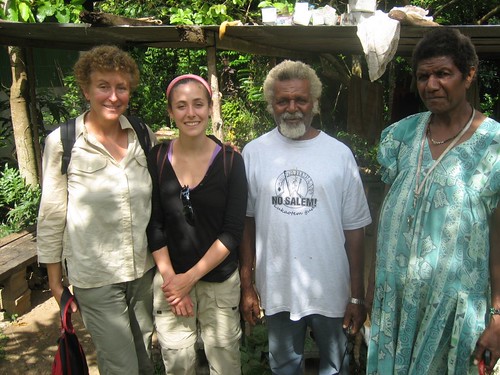
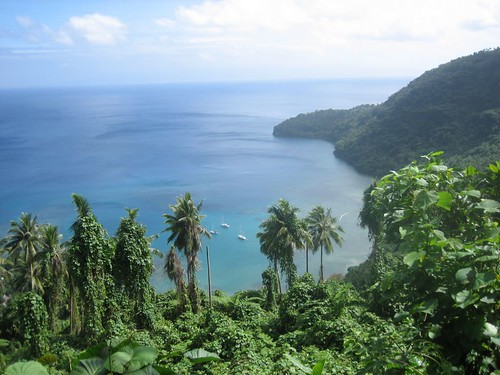
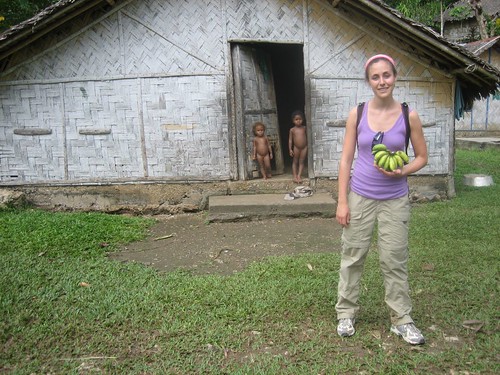 Hannah with bananas and naked little girls peering out of their house
Hannah with bananas and naked little girls peering out of their house
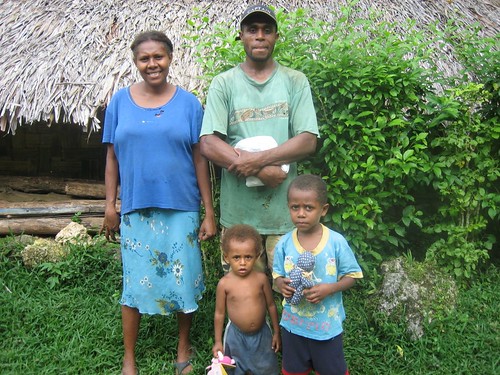
Dickie and family, Loltong,Pentecost Island 
Mark with Chief William, Chief of Tomman Island 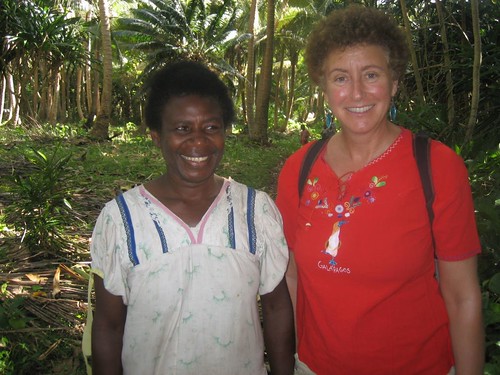
Laura with wife of Chief, Tomman Island 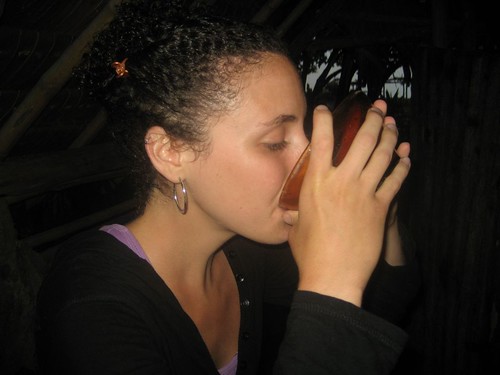
Hannah drinks kava (Southwest Bay, Malekula) 
Hannah checks out huge cucumber (Dixon's Reef, Malekula) 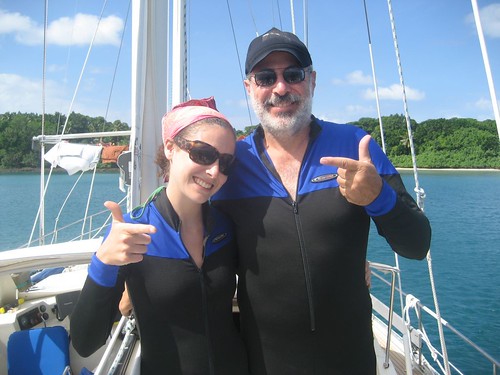
Father and daughter prepare to explore Dixon's Reef, Malekula 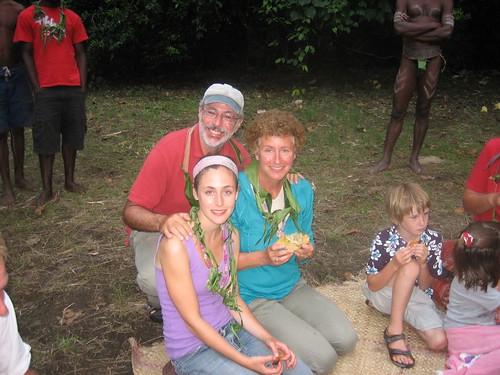
Laplap supper after the Kustom dance, Banam Bay, Malekula 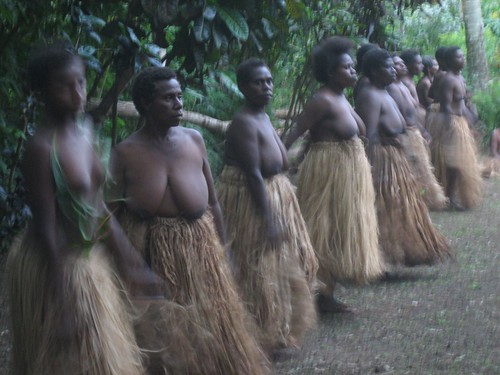
Women dance, Banam Bay, Malekula 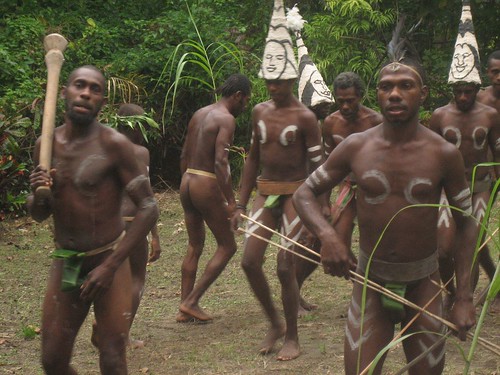
Men dancing, Banam Bay, Malekula 
Change comes to Vanuatu 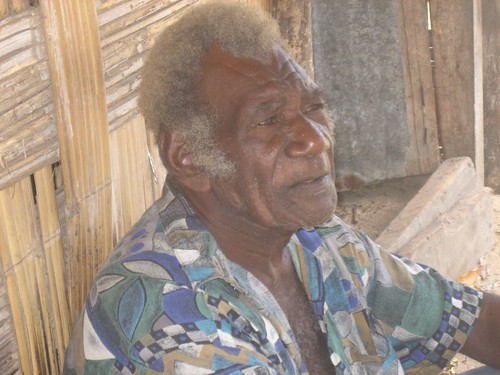
"Longhead", Tomman Island 
Dinner on Intiaq (Karin and Jean-Francois) with the Bahati's (Nat, Betsy, Cameron) and Sam, his wife, and baby Jackson 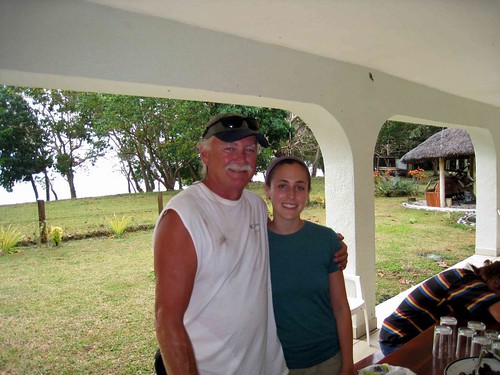
Hannah with Jim from "Cardea"at Lamango Ranch, Malekula 
Solomon and Rita and their family, S.W. Bay, Malekula 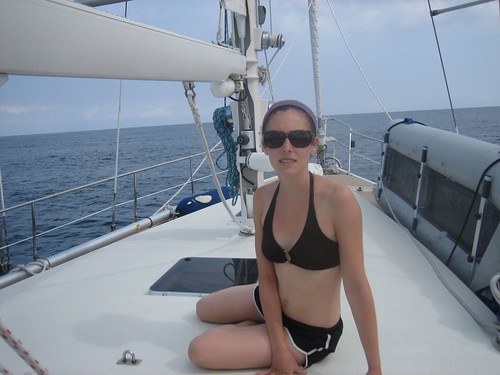
Hannah 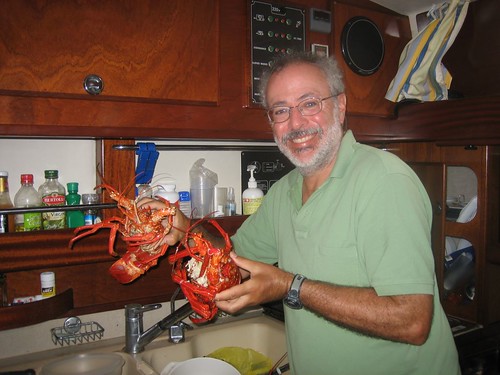
Lobsters in Banam Bay, Malekula 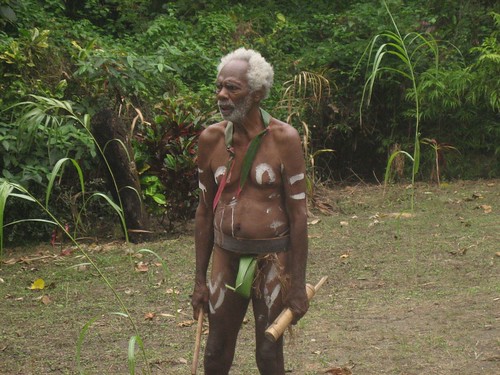
Chief Saitol, Banam Bay,Malekula 
Hannah and schoolchildren, Loltong, Pentecost Island 
Village on Tomman Island 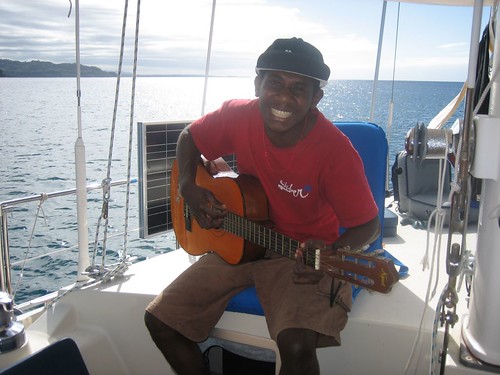
Masint performs for us aboard Sabbatical III at Banam Bay,Malekula 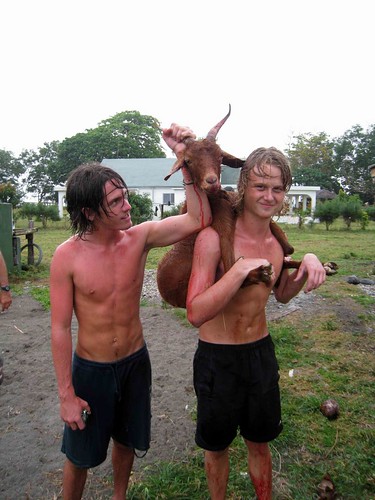
New Zealand boys bring their kill in for butchering, Lamango Ranch, Malekula 
Hannah and Laura in front of the Au Bon Marche Nambatu, the best supermarket in Port Vila. Nambatu refers to radar station number two of the US Navy during WWII. 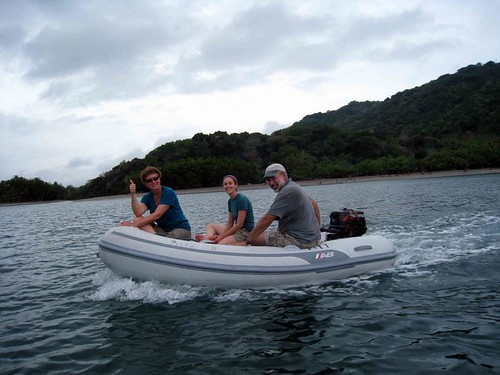
In the dinghy 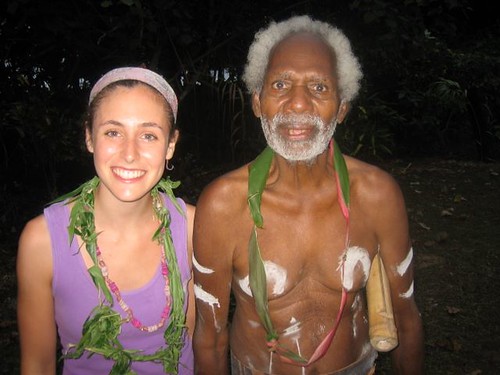
Hannah and Chief Saitol, Banam Bay,Malekula 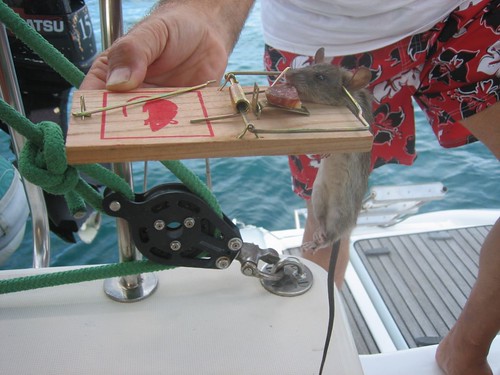
Intiaq's rat get only a small taste of salami before the end comes 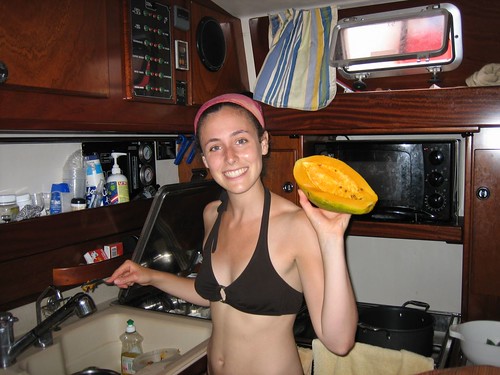
The girl loves paw-paw 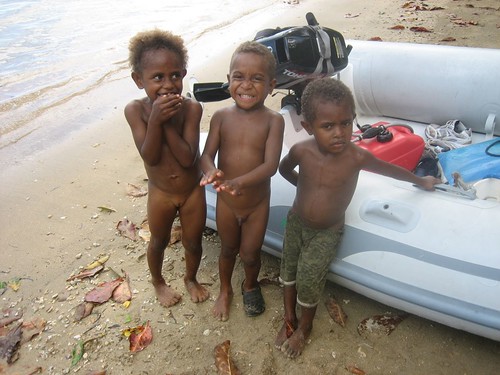
Children at the dinghy, Loltong, Pentecost 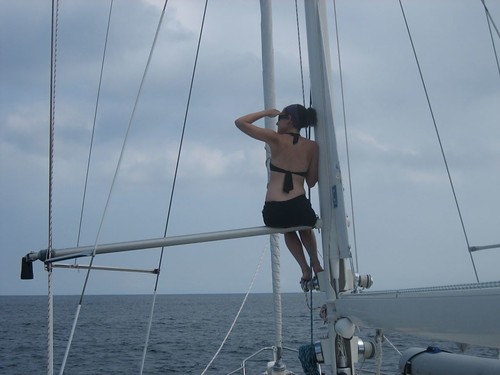
Hannah looks for coral bombies
Hannah reporting from Vanuatu again
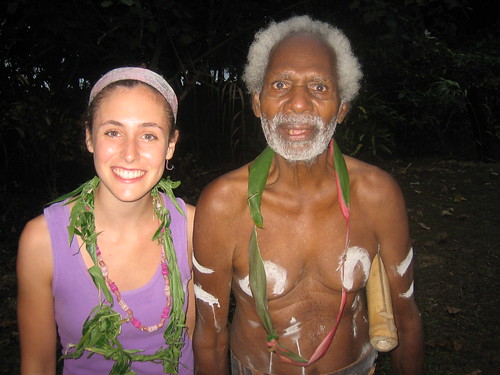
Hannah’s blog: A review of the past few days, starting with July 15, 2009
On our first full day in Loltong, the enchanted-looking bay with encircling green hills, we went ashore with the two other boats in the bay, Midnight Sun and Sorcery, both from New Zealand. After a quick jaunt to see the village chief, Richard, we got back in our dinghies and zoomed over to the far end of the bay to a neighboring village. Unlike others we have visited in Vanuatu, this village was built way up on a hill. As we huffed and puffed and schvitzed our way up, a few school children, heading back to school from lunch break, offered to show us the way there. The school was up on the top of the hill, with beautiful views and a much appreciated breeze. There we met two Ozzie volunteer schoolteachers who showed us around the place. Although they’d only arrived two weeks before, they already seemed jaded about the way the school was being run and their ability to make much headway. It’s got to be difficult to get kids engaged when the former schoolteacher had a habit of writing lessons up on the board in the morning for the kids to copy down, and then calling it a day. As the new teachers put it, school starts whenever the kids arrive, and it ends, well, when they leave. The kids do enjoy school, however, and often stick around until 6 or later in the evening. After watching all the kids do warmups on their sports field, Mom, Dad and I split off from the other couples and did a short walk up a forested footpath leading out of the village. Along the way, we ran into various ni-Vans– chopping kava, carrying massive bundles of banana plants, two very elderly ladies watching little naked toddlers. We spent the rest of the day swimming and kayaking, and enjoying our scenic little cove.
The following day, we went ashore again to take a better look at Loltong village. What I like about this village is that the kids are more precocious than in other places. Whereas in most places we’ve been the kids look shyly from afar, in Loltong, each time we beached the dinghy, a little posse of cute partially-clad kids would crowd around. They played an impromptu game of tag, with me constantly being “it”. They also took to shooting us with little seeds blown out of hollow papaya fronds. We walked around the village and met the paramount chief, William and his wife, Beth. They were a very friendly couple, with kids who have moved away to become doctors and businessmen in Fiji and the US. Afterwards, we took a longer, steeper hike up a path that climbed up a ridge overlooking the bay. We met a 75-year-old woman, truckin up the path in flip flops, twirling an umbrella to keep the sun off her face. She turned out to be extremely outgoing and sweet, the wife of chief Richard, and she talked and laughed with Mom and I all the way up the extremely steep path (which, by the way, she walks up every day, nearly an hour each way, to tend to her vegetable garden). After a while we bade her farewell, and headed back down.
Laura is taking over now – poor Hannah is tired. It is 7:00 P.M. and this is about the time she starts to fade here. Too much heat and too much sun! Anyway, to continue the saga, on the edge of the village we met Jeffrey, a very warm and friendly man whose father worked for the U.S. navy during WWII. Jeffrey was very positive about America and was disappointed to hear that we were leaving the next day. Just a few minutes later we met his son, Dickie, as warm and hospitable as his dad, who offered us fruit to take back to the boat. He climbed up the tree next to his house and started tossing pamplemousse down to Mark. He apologized for only having a small bunch of bananas and a single papaya for us (in addition to all the pamplemousse he had just picked for us). Luckily we had brought along some gifts in our backpack and could repay him with children’s clothing and books (for his two sons). That night we had made arrangements to have dinner prepared by a local woman and listen to a string band. When we came to the village in the evening (with our friends from the two other boats), we found that the string band had been called away to play at a funeral in the village up the hill. Dinner, however, was still on, and we were greeted by songs and smiles by Mary (our cook for the evening), and several village children. It was a terrific dinner – with all sorts of local dishes – and continuous singing by the children. Some of our favorites were “Satan is the loser man” and “We are one big family”. The kids were just so pleased to be singing all their Sunday school songs for us that they didn’t want to stop singing, even when we all said, it was fine for them to go out of the little hut where we were having dinner.
The next morning we left very early to make the 55 mile run to our next anchorage on the island of Espirito Santo. It was a totally windless day so we had to motor, but it was sunny and pleasant. We sailed past the island of Ambae which has a huge volcano on it. We wanted to stop there for a night or two, but we had to keep going as Hannah leaves so soon. We arrived in Peterson Bay, Espirito Santo at 4:00 p.m.on Friday, bumping lightly into a coral head as we entered the anchorage. It is a beautiful place, but somewhat unprotected in the outer anchorage. There is a terrific protected anchorage just around the corner with a small resort, the Oyster Island Resort, that we will move to tomorrow at high tide. The pass to get in is just a few inches deeper than our boat at high tide so timing is important if you don’t want to get stuck. July 18: Collin, and his wife Mary, the owners of the resort, came out in their skiff to guide us through the narrow and shallow pass into the inner protected anchorage in front of Oyster Island. It was a bit nerve-wracking and we went through with only a few inches of water between us and the bottom. It is such a terrific anchorage, totally protected from swell, but with a nice breeze. The resort is very small (8 bungalows) and extremely low key. We went there for dinner and ended up sitting with Collin and Mary, and Collins father who is visiting from New Zealand. It was a lot of fun. They are sailers, and just have this resort as a kind of hobby. They also have a farm in New Zealand (where they raise sheep) as well as run a vineyard. There is still a lot to write, but now it is Monday morning and Hannah leaves tonight so we are off to organize her trip to the airport.
H. & L.
Banam Bay, Malekula to Loltong, Pentecost
It’s Hannah, here, reporting to you from Banam, a lovely, wide bay in eastern Malekula Island. We arrived here two days ago after a smooth sail from the Maskelynes. Despite the gentle weather on Saturday, a low pressure system brought thunder, high winds, and sky-illuminating bolts of lightning the night before. Fortunately, our anchorage, nestled between two very green, lush islands, kept us protected.
After setting anchor in Banam, I inflated the kayak– first riding with Mom, then with Dad. As the sun set– one of the most magnificent I’ve seen yet in Vanuatu– Dad and I met some young boys heading out on wooden canoes to the reef to catch Longmouth (aka Barracuda, the same fish we ourselves caught and ate earlier this trip…yum). The next day we took the dighny out to a reef that extends from the edge of the bay to check out the snorkling. As we swam up to the drop-off, falling from 2 to nearly 100 feet, I almost chickened out and headed back to the dignhy. Even with the reassurance of our guide books and of the locals that there are only “nice” sharks here, I must admit that I find it of little comfort when actually faced with a bottemless blue abyss. But I couldn’t bear to wimp out in front of my fearless, seafaring pirates… I mean parents. So I forged ahead, and the beautiful coral and vibrant sealife, including a very bizzare looking cuddle fish spotted by Dad, made it worth pressing on. I did see two sharks slinking gracefully along the coral, roughly 6 feet each. Go figure.Two other boats who had been at the Maskulyne anchorage with us, Flame from Australia and Kaitorete from New Zealand, sailed into Banam Bay in the afternoon. Kaitorete had caught a giant yellow fin tuna just a few hours before, and were nice enough to give us a huge hunk of it. We seized upon it as soon as we got back on board, eating half as sashimi, and half quickly seared with olive oil and ginger. Unbelievable.
Saturday night we had Kaitorete and Flame over for sundowners, along with Steve from Irony, who came in after us on Saturday. It was a very lively gathering, and I spent most of the evening playing with the two adorable kids from Kaitorete, 4-year-old Megan and 7-year-old Matthew. This morning, two young men from the village brought us 3 lobsters (actually, crayfish, to be precise), a sack of lemons, and a bunch of bananas. The lobsters were huge, and made for another fresh and delicious lunch. Before that, Mom and I worked up our appetites by swimming out to meet the kids and Annabelle from Kaitorete, and Diana from Flame, who were puttering around the coral bommies near the shore, spotting fish.
In the early afternoon, a young boy came by, carrying a guitar in his canoe (which he somehow managed to keep meticulously dry). Masint is 18 years old with very good English and the sweetest, most genuine smile. After a few minutes of chatting he came aboard so he could play some songs for us on his guitar. He performed three songs in Bislama, played guitar very well and sang with enormous enthusiasm. Mom and Dad gave him one of the MP3 players they had loaded with reggae and Vanuatu “string band” music. He was very pleased. “Nambawon!” he kept thanking us, always with a thumbs up and a broad smile.
Chief Saitol, founder of the Hefah Sar Culture Club here at Banam Bay, is an 85 year old, white-haired, big-bearded and charismatic chief– a legend among cruisers. He organizes performances of the village’s traditional Kustom Dances for visiting yachties. We organized with Chief Saitol to see the dancing Monday afternoon, and headed to shore with Kaitorete, Flame and Irony. As we distributed a bag full of cell phones, which the villagers had asked us to charged on our boats (no cars, no electricity, but everyone has a cell), two German boats sailed into the bay just in time to join us for the performance.
The villagers of Banam Bay belong to the greater Malekula tribe of the Small Nambas, distinct from the Big Nambas, their former rival tribe. And in their traditional costumes, consisting of a strategically-placed banana leaf, whether or not they are in fact small or big nambas is really for each to judge. About 15 male dancers so attired performed rhythmic steps to the beat of percussion instruments played by Chief Saitol and two other older men, who sang together in chorus. Lucky for me, I got to hold hands with my new friend Megan almost the whole time. Afterwards, women, ranging from children to grandmothers, performed a female Kustom Dance, wearing their traditional grass skirts. At the end of the event, Chief Saitol gave effusive thanks to the sailors for coming, and implored us to tell our friends in American, NZ, Australia, and Germany to come see his village…”Boost tourism!”. We finished with a sort of mini feast: a fresh coconut for each person to drink and a big spread of laplap, the traditional dish of flattened and fried manioc (or breadfruit) and meat, in this case chicken. Although the event was definitely a tourist attraction, given that the villagers would typically only perform the Kustom Dances at special occasions during the year, it still felt authentic and very much Vanuatan.
July 14:
It’s the following day now, Tuesday, and Sabbatical III is safely arrived in Loltong, on Pentecost Island. Phew! We left at 6 am this morning from Banam Bay, and had a whooper of a sail, averaging 7 to 8 knots the whole way. We were feeling great, approaching our destination 2 hours earlier than planned, when a nasty squall decided to park itself over us and Pentecost, effectively blowing straight out of the mouth of Loltong bay. With the rain driving right into our faces, and the wind howling at 25-30 knots, there was no way to make out anything, let alone the markings that supposedly indicate the safe entrance through the reefs. Moreover, Loltong bay, like much of Vanuatu, has not been well charted, so we could not rely on nautical charts. Just as we were about give up any hope of entering safely, thinking instead we would continue on to another island where we hoped conditions would be milder, Midnight Sun, a boat anchored in Loltong, offered to guide us in via VHF radio. Following his instructions, we safely approached the narrow break between two reefs that flank the sides of the bay. Now that we are anchored close in to shore, it is hard to believe it is blowing so hard just a half mile out. This anchorage is unlike any other I’ve seen here: the water is glassy and deep aquamarine, reflecting the green hillside that drops sheer down to the water and encircles the bay like a towering, vine-covered ampitheater. There are frequent rainbows, including a fantastic display that showed clearly against the hillside from end to end.
After a random assortment of snacks and water-guzzling all around, Mom and Dad have collapsed into their front berth for a very well-deserved nap. And now let me say what Dad would never say about himself: he is an outstanding captain. He is competent, responsible, and ready for anything that the sea, wind or weather might bring. Thanks Dad!
On that note, I’ll sign off. Our position is …
Hannah
From Southwest Bay to Awai on Laura’s B-Day
We are now anchored off of Awai Island in the Maskelyne Islands, a group of small islands that lie to the southeast of Malekula. As predicted, the wind shifted to northwesterly from southeasterly during the night (at 5:05 am to be exact since the 180 degree turn of the boat set off the anchor proximity alarm). When the wind has west in it, anchorages on the west side of islands become uncomfortable and possibly dangerous. So we set off for Awai which is nestled between three islands and is pretty much protected from all directions.
As this is Laura’s birthday, I promised to catch her a tuna. This put a lot of pressure on me, but I was able to deliver 5 1/2 hours into our 6 hour sail. The tuna was quite small but tasty. Hannah made pina coladas and we toasted Laura as the rain pelted outside accompanied by flashes of lightening.
Yesterday we did not do much. Hannah needed to rest after our kava drinking, so Laura and I did a short snorkel at Ten Stick Rock. Later in the afternoon, Rita and Solomon and four of their children paddled out in their outrigger canoes to visit us. We befriended them last year and we were all happy to get together again. They brought us another load of fruit and we had special gifts for them that we brought from the States. We chatted in the cockpit until the sun was about to set. Right after they left, Scott, the son of the “Lamangoe” ranch owner who was so hospitable to us the previous day,and his pal, also named Scott and also from New Zealand, came to Sabbatical III for sundowners and snacks, as did Jim of Cardea. We had a great time with them, sampling various non-kava beverages, among them the “Q. F.”, a drink whose full name cannot be spelled out in this blog.
We will probably head up to Banam Bay on the east coast of Malekula tomorrow, weather permitting.
M.
Goat killing, bumpheads, and kava
Goat killing, bumpheads, and kava
Since our last blog we spent a couple of very quiet, but nice days in the anchorage near Dixon Reef, and then sailed down to Southwest Bay yesterday. Dixon Reef turned out to be an amazing place for snorkeling. The reef is very expansive, with gorgeous coral formations and tons of colorful fish. For a while we just kept seeing lots and lots of beautiful, but small fish, but then we were rewarded by seeing a large school of bumphead parrotfish. They look just like the name would indicate – huge fish (up to 4 feet long), with a tremendous long face topped by a great big bump. They look more like a cartoon than a real fish. They travel in schools and we happened upon about 10 of them feeding on the reef. They let us follow them for quite a long way. It was a real thrill. We also saw a few white tipped sharks and a sea turtle. The village of Dixon Reef is not near the anchorage so we did not have much interaction with the locals, except on Sunday when we walked to town. The anchorage was beautiful, but a bit uncomfortable as it was not well protected from the ocean swell. The only other boat there was Cardea, with our friend Jim on it.
We have just spent our first day in Southwest Bay anchored outside the village of Lembinwen. We were here last year and enjoyed it very much so we wanted to bring Hannah here. We have had quite an adventure today. As a matter of fact, Mark and Hannah left the boat an hour ago to go drink kava on the beach with the locals. It was a rainy day and we almost did not leave the boat this morning, but I am so glad we did. First we went to the village where we walked around and met some of the villagers. People here are friendly, but extremely shy. A few people remembered us from last year.
There is a small river that runs by the edge of the village and empties out into the ocean and on the other side of it there is a very large ranch owned by a New Zealander. The ranch has sheep, goats, cattle, chickens and a few riding horses. It is very large, covering over 200 acres of land, and it has the only western style home on the island as far as we can tell. We had caught glimpses of the lovely ranch from the water, and had even visited the grounds last year, although the owner was not in the country at that time. The ranch sells their beef to markets in Vanuatu, exports some to Australia and New Zealand, and gives away a lot to the villagers. This time, when we went to visit, we were very lucky, as the owner’s 22 year old son was there. When we walked up to the house we saw him and a few other white boys near the shed where they process and store meat and eggs. We went to say hello and realized they were right in the middle of butchering several goats. There were severed heads and entrails sitting in a huge pile on the ground, and a lot of blood.
The owners son, Scott, is an extremely friendly, outgoing and generous young guy. He spends several weeks a year here, and the rest of the year in New Zealand where he owns his own butcher shop. His dad apparently owned about 50 butcher shops in New Zealand and just fell in love with Vanuatu and decided
to build a ranch here and now lives here about one quarter of each year. Scott explained to us that a client of theirs had just put in an order for 10 goats and so they were in the process of killing and butchering the animals just as we arrived. It was not a pretty sight, but extremely interesting. Scott slung a rifle with a scope over his shoulder and we followed him out to the lovely meadow where the goats were grazing. He felled three more goats with a single shot between the eyes (from 50 meters) as we watched and then two of his friends ran out and slit their throats (anyone hungry yet?). It does sound kind of horrible, but it really was so interesting. Two of Scott’s friends are young New Zealanders who are in Vanuatu teaching English to some of the kids in the next village over (about a mile away). Another of his friends is an engineer who comes out to Vanuatu once a year or so to repair equipment on the ranch. Scott asked if we would stay and have lunch with them. It was a hard invitation to refuse. The home is not ostentatious, but is very lovely, with a huge veranda overlooking the bay, the palm covered hills, and the beautiful water. Small outriggers paddle back and forth across the bay with fishermen. All of the local people love Scott and his family because they are apparently quite generous and are continuously doing things for the villagers – including paying for the rebuilding of an entire village after a hurricane several years ago, giving away meats and eggs, and employing many of the locals on the ranch. Scott insisted on preparing lunch for all of us – 7 guests in all. He grilled meat (of course), prepared potatoes and salad and bread (baked by a local woman) and insisted on giving us several steaks to take back to the boat with us. Then he asked us to meet him in the village to drink kava at his favorite kava bar. Mark and Hannah and Jim all went – but I was too exhausted to leave the boat. Hope they get back soon so we can hear all about it!
L.
This is Mark now, just back from 2 1/2 hours of “kava crawl” though the kava bars (nakamals) of Lembinwen village. This village of 300 persons has 6 nakamals. The first nakamal Hannah and I visted was in a thatched hut and the second (“Gideon’s”) was outside a hut (the rain had stopped) further from the beach. We sat on plain wooden benches. One typically drinks kava standing up, taking the whole portion without taking a breath, and then spits afterward either onto the dirt floor of the nakamal or outside. We were with Jim of Cardea, the four Kiwis, and two Vanuatans who work on the ranch. It was very mellow and Hannah and I had several cups of kava over two hours.
Kava makes conversation easy and makes it comfortable to just hang around in the nakamal being thoughtful, or at least that is the perception. The kava drinking was still in full swing when Hannah and I left for the boat but we thought Laura might be worried about us. I ran into Solomon whom we know well from last year and invited him and Rita, his wife, to visit us in the mid-afternoon tomorrow. At five in the evening, we will have our Kiwi friends and Jim over for beers and snacks. So our social schedule is quite full, in spite of the rain.
M.
Dixon’s Reef
We are now anchored at Dixon’s Reef on the west coast of Malekula Island. We arrived here yesterday afternoon after a 4 hour passage from Millipe.
We spent our last full day at Millipe snorkeling, reading, and talking with local people. We were presented with even more pamplemousse, coconuts,bananas,passion fruit, and papaya. So much that its consumption seems impossible.
An hour after arriving in Dixon’s Reef, we got a radio call from our friend Jim on Cardea who had just anchored in Southwest Bay, 8 miles to the south, after a trip from Epi Island. He picked up anchor and came up to join us in Dixon’s Reef. There are no other boats here nor did we see any others in Millipe on on our passage north.
Jim came over for a fresh fish dinner. I caught a strange looking fish just outside the reef on the way in. It was long and thin, with a very elongated mouth full of many sharp teeth. To be sure it was safe to eat, I took a photo of it’s head and brought it to shore where we met a local man loading wood onto his dugout. He said it is a “longmouth” and was perfectly safe to eat. My kava buddies in Millipe had said that they ate “longmouth” but I did not know what that looked like.
Anyway, the fish was delicious and more than enough for the four of us. Hannah made a frozen rum drink for us to enjoy before the meal — fresh passion fruit juice, coconut milk, frozen banana, mango, and a healthy dose of rum
Today we will snorkel on the reef. The water here is very clear. The seas are way down and the sky is almost cloudless, so it should be a great day to see the coral and fish.
The location of Sabbatical III is S16 degrees 21.011 minutes E167 degrees 22.968 minutes.
M.
Millipe Bay, day at Tomman Island
July 1, 2009
Millipe Bay, day at Tomman Island, Population 300
In the morning, a man paddled by with a canoe laden with wooden planks. I learned he was chief WIlliam of Tomman Island. We told him we’d be there shortly, and he said there would be activities for us to see on shore, including a football (soccer) match, and a man with a long head. One of the reasons Dad was keen on coming here was to see the “long-heads”, as they’re called, an old tradition of elongating childrens’ heads that was stopped by the missionaries.
A lot happened today, so I decided to write it in bullet points:
-Chief William and wife Annie greeted us on the white beach of Tomman Island, which is across the straight from Millipe Bay, where we are anchored
-At their lovely, flower-filled compound, William took out a clay bird, made by an elder family member, and dictated the village creation myth while a daughter translated into French. According to the myth, 5 brothers in Millepe sent a bird to kill a large clam in the ocean. The bird planted a tree in the clam, from which Tomman Island grew.
-WIlliam and Annie guided us through the village, showing us water sources, a primary school, churches, and the dance ground for the island’s traditional ritual dances. Only members of Chief William’s family can dance, and they do so to the drumming of large tamtams, a special kind of Vanuatan drum.
-Evidence of a confused colonial history: Although they are right across the bay, young people in Tomman Island speak French while people in Millipe speak English. Even crazier, in Tomman, the older generation speaks English while their kids speak French.
-I talked a lot (in French) with a young girl named Marilyn. Since neither of us speak French very well, there was a lot of miscommunication, and just nodding and smiling. What we did understand we high-fived to– figuring out we are both the same age, both un-married, and both prefer the village life to Port Villa, the capitol.
-Annie told an interesting story about the “Hidden Time”– what they call the period in thier history before missionaries arrived. In the hidden time, people from other villages would often come and kill women and children in Tomman, so the village moved. “Then we learned about God”, Annie said, “and now, no more” she shaking her head.
– They took us to see the last remainining long-head, an old man with what seemed to be an especially accentuated forehead. This used to be done by binding the heads of babies. He claimed to be 95 years old, born before missionaries and before WWII, during which he worked with the US Navy. He had a full head of hair, and a toothless smile.
-Finally we came to the village’s big sports field, ringed with palm trees. Today was the football match between Tomman and Southwest Bay, and everyone was out cheering, including fans from Southwest Bay and Millipe.
-Girls were playing volley ball on a court next to the field, and although no one was watching, they were pretty good!
-We drank coconut milk from green coconuts Annie cut for us
-William expressed his appreciation for Dad’s friendship profusely
-We bought coconut crab from William and Annie, who gave us a long demonstration of how to kill, cook, and remove “his mess”, and we also bought the clay bird and a clay mask from the elder man
-After lunch and a short nap, Dad went to drink kava with Chief Holland, Bill and Newman of Millipe in the Nakamal (a special place for men to drink kava)
-They made fun of him for coming exactly at the time they had agreed on– very American, they said
-After about 7 shots of kava, Dad stumbled back onto the boat, high as a kite
-Dad sat on deck, completely zoonked– don’t worry, I captured it on film
-Bill and Newman came over in canoe to help us cook coconut crab
-As we waited for the pot to boil, Bill and Newman explained the different methods by which they catch crabs, lobster, flying foxes (bats), squid, octopus, etc
-They also pointed out good locations to snorkel in the bay, but warned of a taboo area, inhabited by a dead man’s spirit
-They explained the Vanuatan “grade-taking” tradition, whereby men, who have the intention of becoming chief, attain higher social ranks by ceremoniously killing pigs
-We then enjoyed “Nambawan!” (say it phoenetically) coconut crab on deck while the sun set
-Bill and Newman said so long, as they paddled back to shore for more kava-drinking
-Dad burned reggae CDs for Bill, a self-proclaimed Reggae Man, and chief Holland
-Mom and Hannah made delicious babganoush and were generally domestic as Dad lay down, waiting for his kava buzz to wear off
~Hannah~
Paradise.
Paradise. I think I’ve finally found it. I’m sitting in the main salon, swaying in the gentle roll of a small, shallow bay, fringed by a white sand beach where the local fishermen keep their wooden outrigger canoes. The sun just set pink and purple over the palm and banyan trees that cover the low-lying island.
How did I get here? Just a week ago, I was in Evanston, IL, running through the torrential rain that punctuated the end of my graduation ceremony from Northwestern; then I drove across country with my friend Hannah to NY where I embarked on a marathon of flights: from NY to LA, from LA to Brisbane, Australia, and then from Brisbane to Port Villa, Vanuatu, where Mom and Dad were waiting at the airport.
We spent the first two days in Port Villa, the bustling urban capital of this island nation, population 210,000. We stocked up on food at the “Nambatu†grocery store (just say it phonetically and you’ll get the meaning) and the open-air market, walking around (and shvitzing our heads off), and sleeping what seemed to me to be absurdly long hours (although to cruisers, 11 hours is standard). On the second night we had “sundowners†with the couples of three other boats. We drank wine and toasted to our various accomplishments, including my graduation, two recent wedding anniversaries, and the successful capture of a wily rat that had been eluding our good friends on Intiaq (he had just sunk his teeth into a nice piece of salame when the trap sprung and, well, that was that).
Yesterday we did a mini-sail over to another bay for an afternoon snorkel, before heading out for an overnight cruise to Malekula and Tomman Islands. Although I planned to be a good crew member and stay up as long as I could, a combination of jet-lag, fresh air, and an anti sea sickness pill made it physically impossible for me to keep my eyes open. I did manage to get myself on-deck for Mom’s 1:30-6:00 AM shift, and I watched the stars and then the sunrise through intermittent naps.
A long, slow sail paid off when we arrived here at Millepe bay, protected by Malekula on one side an Tomman island on the other. Almost as soon as we anchored, villagers began tentatively canoeing out to say hello. A boat of young boys brought eight pamelos, a boat full of girls brought bananas and grapefruit. We gave them toys, lollipops, and t-shirts in return. Soon after, we went to shore to pay our respects to the chief and see the village. The young chief greeted us, as did the same young girls who had paddled up to our boat. One of them spoke English particularly well, and they all guided us through what we learned were actually three separate villages, but which they refer to as Millipe. Although there are only 100 inhabitants between the three villages, each has a church of a different denomination. They took us to the Seventh Day Adventist church in the first village, with beautiful wood carvings and gardens with engraved stones in front of the thatched praye
r house. An elder man showed us inside the prayer house, and donned the ceremonial church sacraments, including a wooden crown, spear and sword (we aren’t sure this is exactly how the Seventh Day’s do it in the US). We walked along a beautiful path between the villages, swept clean and lined with manicured bushes and flowers. It was as if we were in a tropical garden. Along the way, the girls and a growing party of children and relatives pointed out the island’s bounty: lemon, guava, grapefruit, pamelo, banana, pineapple, papaya, mango (not in season!!!!), all kinds of tubers, cocoa nuts, coconuts, green vegetables, fresh chicken eggs—they offered and we gladly accepted.
We finally arrived back at the beach where a group of men were preparing kava, a special intoxicating drink enjoyed by the men in Vanuatu. In fact, Malekula is known for its particularly potent variety. Dad was invited by the chief for a kava session tomorrow afternoon—“chief and chief†he said, smiling.
A beautiful sunset kayak ride with Mom rounded out this ridiculously amazing day, and now its time to get my 11 hours.
Allay! (Goodbye in Bislama)
Hannah
(PS Our position is S16 degrees 34.722 E167 degrees 29.545)
Ripped genoas and Devils Point
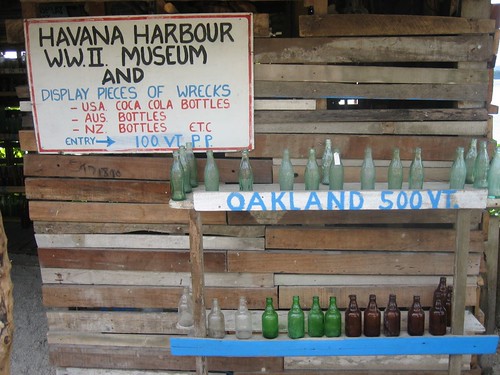
It is Tuesday evening, June 23, and we just returned to Port Vila to be sure we were here and ready for Hannah’s arrival on Saturday. The 3 day Government festival in Mele did, indeed, turn out to be a 3 day festival – going on non-stop all night and all day. It did not make for a peaceful setting for the boat with all the amplified music coming from shore throughout the night, but we were kind of stuck there because of the weather. The winds picked up on Friday and Saturday and it rained and blew hard. No matter how hard it rained, or how the wind howled, the party onshore just kept on going – much to my chagrin. We were guessing there must have been a lot of pretty drunk or kava-ed out government officials out there by the third day.
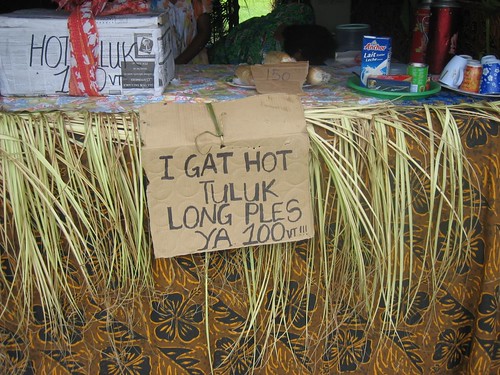
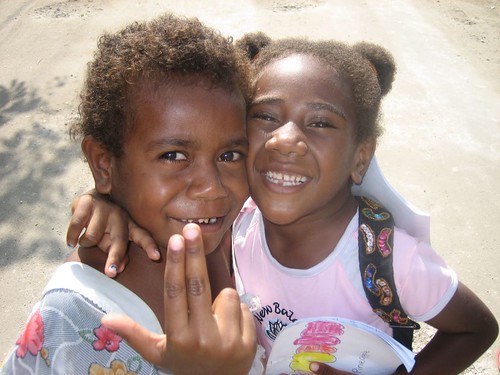
When we finally left on Saturday morning the weather had improved quite a bit and we were able to sail up to Havannah Harbor – about 25 miles away. It is a fairly difficult sail as you have to go around a point of land known to local sailors as “Devils Point”. It is a well deserved name as the wind just pours over the hills there and kicks up turbulent seas and big waves. The wind was gusting up to 35 knots and we had to reef in our sails. Just after we rounded the final nasty portion of water and were heading into the smooth and protected waters of Havannah Harbor, we heard a loud “ka-ching” and saw that we had ripped the genoa (the front sail). There is a large metal ring sewn into the clew of the sail and reinforced by hundreds of stitches that holds the jib sheet. It must have weakened without us knowing it, and the strong gusts must have helped the stitches just rip apart, so the entire metal ring ripped right out of the sail. Unfortunately, while this left the sail itself in pretty decent shape, it was unusable since there was now no place to tie the sheet and thereby harness the sail. We rolled it up and just sailed with the mainsail into the bay.
There are several anchorages in Havannah Harbor and we selected one about 2/3 of the way inside the bay (maybe 5 miles from the mouth of the bay) to be sure we were in a calm place and also because we knew two other boats there. Even though it was still quite windy, it was well protected from swells and after anchoring the boat it was just as peaceful and calm and quiet as possible. The two boats that were there – Betsy and Nat from “Bahati” with their 19 year old crew member Cameron and Jim from “Cardea” – have been friends of ours for some time now and we spent a couple of days there together – taking turns at having pot-luck dinners on our boats. The weather finally cleared and we were even able to do some swimming and snorkeling. There is a cute little town nearby with a brand new road being built through it. The road is sponsered by the U.S. and all the locals were very happy to tell us about it. There are only a few houses, and a school along the road right now – no stores – but maybe things will change once the road is completed (too bad). It is going to be a nicely paved road and will eventually go around most of Efate island.
There was one very interesting little museum on the road – the “Havannah Harbor WWII Museum”. It is just a 10 by 20 foot shack filled with coca cola bottles, beer bottles and some old wreckage from WWII. There is even a wing of an old Corsair fighter plane propped outside the door. The museum is owned and run by a very friendly Vanuatan man, Ernest, who has been collecting and displaying his stuff for the past 34 years. He has coca cola bottles from over 350 different U.S. cities – all dated before 1945. Each one has the name of the city it came from and the year it was manufactured right in the glass on the bottom of the bottle. He managed to pull one out for us from Providence, RI when we told him where we are from. Everything in the museum was left behind by the U.S. navy which used Havannah Harbor as a staging point for the war in the Pacific. There were more than 80 naval vessels in the bay here during the war – starting in 1942 – and it was the major staging point for attacks in the Solomon Islands (Guadalcanal) and New Guinea – both of which are nearby.

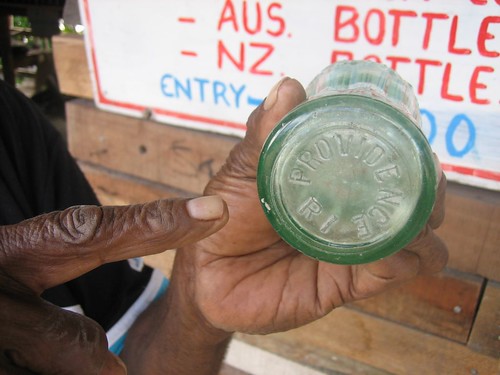
To get back to Port Vila (and points beyond), we had to have a jenoa sail up, so Mark and I put up the new large genoa that we had built for us in New Zealand last year. Thank goodness for that! Our sail back to Port Vila was even harder than the sail to Havannah Harbor, with winds and seas at and around Devil’s Point leaping all over the place. A very uncomfortable ride. Luckily the whole sail back here from Havannah Harbor was only 6 hours – with the two hours before Devil’s Point being calm and pleasant. We were glad to reach Port Vila and tie up to a mooring ball in such a nicely protected, calm place once again.
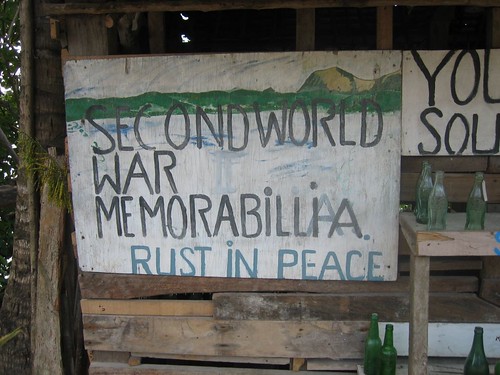
Tomorrow we will try to get the ripped genoa fixed.
L.
Mele, Vanuatu
June 18th, 2009
We left Port Vila on Monday and sailed just a few miles away to Mele Bay – it is a quiet little anchorage outside the village of Mele which is the 2nd largest village in Vanuatu with 6,000 inhabitants. Because it is only 10 minutes by car (and one hour by sailboat)from Port Vila, it is quite modern, and although poor by western standards, quite wealthy for Vanuatu. It is clear that most houses have t.v. and everyone has a cell phone. Lots of simple thatched houses, but also lots made from tin, or even whitewashed with real windows. Lots of people hang yams outside on lines and at first we thought they were rows of sausages. This might make sense as besides yams, the other popular household item is pigs – lots of them – and really huge ones as well as many piglets. Mark and I walked around the village when we arrived and it was clear that we were in a neighborhood that is very used to tourists. No one gave us a second glance. It has been nice getting out of Port Vila. The water here is very clean and we have been able to swim every day the last 3 days and take walks on the long beach.
It has not exactly been a quiet anchorage though. The province of “Shefa” which we are in is apparently celebrating 15 years of being in existence and there has been nearly non-stop music and festivities being held at the large soccer field which is quite close to the anchorage. Last night the music and amplified prayers started at 7 p.m. and seemed to go on almost without stop until this morning at 7:00. We walked over to the field today to see what was going on and it looks like this government holiday is going to continue for a full three days! It was fun to be there – lots of dignitaries (including the president of Vanuatu!), rugby tournaments, comedians (who we could not understand), games for the kids, Vanuatu string band and reggae competitions, and best of all -food booths. It was nice to hang around and watch everything. For the last 3 nights there have been 5 or 6 boats with us in the bay – all of them from New Zealand. One night everyone got invited to “Midnight Sun” – a boat built by an Australian man, but sailed out of New Zealand. When he built the boat it was a 40 footer, but after twenty years of sailing he decided it was not big enough and decided to just add 10 more feet at the back. It made for an excellent party boat with more deck space than any other boat we have been on. Today all the boats left and we are tring to decide whether to stay here a few more days,head north to another anchorage, or head back to Vila to get good internet access (always important). The weather is pretty terrible – lots of clouds and some rain. It is really beautiful when the sun comes out, but that has not happened more than a few hours every day. Happy 31st anniversary today to us!
Saturday June 13, 2009
We are still in Port Vila. A local theatre group is performing in town for a week and we decided we would walk up the hill to watch them. It was to be performed at the Chief’s Nakamal (meeting house). We took our little foldable chairs and trudged up the hill with some friends (along with some mosquito spray) to see the show. When we got to the nakamal we heard wailing and moaning and saw groups of people sitting somberly outside the thatched house. Mark and our friend Nat went inside to see what was going on. Much to Mark’s surprise there was a dead body laid out on a table with women keening over him loudly. It turns out that a very big chief on the island had just died and they were holding a wake for him in the nakamal. Needless to say, the show did not go on. Mark has been busy doing lots of boat prep (still) – working on some problems with our water pump, replacing the VHF radio, changing our propane tanks and other essentials for the boat. Our friends from Intiaq are moored right beside us. We had not seen them for almost two years. They are great people and we hope to see them a lot while we are both together in Vanuatu. We are having pretty quiet days, but seem to socialize with one boat or another most every night. We are anxious to get out of town and sail to a nice, clean anchorage, but are still not quite ready. We promise more exciting blogs soon…… L
June 10, 2009 : Officially checked in and ready to roll
We ended up spending a full week in Vanuatu before we were able to actually go ashore. It is not exactly life in the fast lane here. We never made it to shore at Aneityum, the first island we stopped at in Vanuatu. We were a bit nervous about getting off the boat there since there was no way to officially check in and we had read that if the wrong person happened to see you there you could get a big fine and other penalties. We contented ourselves with sleeping a lot and seeing a few visitors – first a local guy, Joseph, who came by in his outrigger, and then with two boats that shared the bay with us over those few days. Probably overly cautious, but we did not want to risk our ability to stay in Vanuatu this year. After an absolutely glorious overnight, full moonlit sail from Aneityum we dropped our anchor on Sunday morning in Port Villa. We were stuck on the boat all day Sunday because customs and immigration don’t work week-ends here and they
are quite strict about observing the “stay on the boat until checked in ” rule. On Monday morning the quarantine boat came by the anchorage and, after taking away all of my remaining fruits and vegies ( exactly 2 onions and one garlic clove), we were free to go to shore to complete the check-in with customs and immigration. Unfortunately we could not get our dinghy engine to start up and it was too far for us to row the dinghy to shore (it is a big, tubby inflatable). We did, however, move ourselves over to the mooring area with all the other boats. We ended up right next to one of the boats that was with us in Aneityum, as well as Lorna, another Amel Supermaramu (same boat as ours) who we were very friendly with in New Zealand a year ago. Bo, the Swedish man on Lorna, saw us having trouble getting our outboard started and offered to help diagnose the problem. Within minutes it was purring like a kitten and Mark and I hopped onboard and took care of
customs and immigration. It felt great to walk on dry land and we took care of some necessities – like getting money, a sim for our cell phone , eating lunch out (a thrill at this stage) and finally, for a highlight of the day, stopping at the huge vegetable and fruit market and stocking up on some oranges, bananas and sweet, huge, pamplemousse. We finally feel like the trip is starting. It has certainly been a big setup time – 3 weeks of preparation in Australia, 1 week at sea, and 1 week on land before we are back to our new “normal” life. L.
Safe arrival in Port Vila
We arrived safely in Port Vila about 8 hours ago (11 am this morning). The winds were good, the seas were calm, and there was a full moon in a clear sky. All in all, an excellent sail north.
Tomorrow we will get formally checked-in and move over to a mooring. There seems to be good wireless in the mooring field now, so perhaps we will get ourselves an account and be able to use Skype and check our email accounts. More tomorrow.
M.
Departure for Port Vila
We are leaving in 30 minutes for Port Vila, approximately 182 nautical miles to the
northwest. The trip should take us 26 to 30 hours in the forecast winds. The route takes
us to the east of Tanna and to the west of Erromanggo Islands.
M.
Resting in Aneityum
This is our second day here in Aneityum and we have not left the boat yet. It is really windy and we are too lazy to think about setting up the dinghy and engine. Maybe tomorrow. There is one other boat in the bay next to us called “Sunstone” We invited them for tea today. (One of my favorite parts of sailing – inviting people over that you have not even met – you just see them on their boat a few hundred yards away and they look sympatico). Really interesting couple – they are originally from England – but the man grew up in the States, served in the US Navy, became a teacher and then a school principal. She was also a teacher. Both are avid sailors and racers. They have sailed around the world 1.5 times in the past 12 years – spending long stretches of time in New Zealand and Australia. They have a classic Sparkman&Stephen’s centerboard sloop made of wood. They are leaving tomorrow for Port Vila (the capitol of Vanuatu) and we will probably catch up with them again there
.
We have heard from several very good friends of ours and all of them are coincidentally in Tanna right now, the next island up the chain. We will all meet up in Port Vila next week and there will be lots of i socializing. How fun.
The island here looks lovely and is supposed to have excellent snorkeling with a huge protected reef – but it is very windy and quite cool so I don’t think it likely that we will get in the water. Aneityum is cool because it is the southernmost island in Vanuatu. In the winter the temperature ranges from 60 degrees to 74 degrees. There are no ‘kustom’ (traditional) villages or ceremonies anymore. The missionary who came here 150 years ago converted almost everyone to Christianity within a few years, although it is said he could not easily stop the custom of strangling wives on the husbands’ death. Women apparently insisted on this right. We expect that this has changed by now.
L.
Safe arrival in Aneityum (Anatom) Island, Vanuatu
We are currently anchored in the sheltered bay of Anelcauhat, on Aneityum (Anatom) Island, Vanuatu, having arrived about 3 hours ago. Our position is:
S 20 degrees 14.4 minutes
E 169 degrees 46.6 minutes.
The wind came up up three days ago. It was later than forecast, but to make up it’s tardiness, it blew harder than forecast. We had 25 knots for much of the time and seas rose to 12 to 15 feet. We sped along but it was not very comfortable. Our friends on Priscilla, who left Australia three days after us, decided to return to Australia after two days out. They did not have as good an angle to wind as we did, so they probably did the right thing. We had the wind aft of the beam the whole time it blew since we had done so much “easting” in the previous days.
It was squally when we approached Aneityum but the entrance to the bay was not difficult. There is one other sailboat here. The wind is still blowing hard and it is raining on the slopes but it is well protected in this bay.
We have already had a visitor aboard. Joseph, a teacher in the secondary school, paddled over in his outrigger. He will help us to arrange a formal check-in sometime during the next few days. There is a barge/dredge and tugboat that just came up from New Caledonia, and a Customs/Quuaratine/Immigration crew will fly out from Port Vila to check them in, and we hope us as well.
For now, all we want is to catch up with sleep and clean up all the sailing gear strewn around the boat. Laura, in particular, is happy not to be out in the rough sea for another night. She says she has reached he limit.
M.
Day 5 at sea from Australia to Vanuatu
01:15 UTC May 30, 2009
S 26 degrees 7 minutes
E 163 degrees 39 minutes
COG: 56 degrees
Speed: 7 knots
We are still motoring along. The weather is actually very beautiful and the seas are so nice and calm that it makes the trip easy (relatively). It is amazing that we have not had wind since the first day and we are now starting our 5th day at sea. The grib files promise a good wind should pick up later today and then we should have at least a couple of days of wind in our favor. We need three days to get to Vanuatu so it looks like things should go well. We are both now in the rhythm of the trip and have actually been able to do 7 or even 8 hour shifts, allowing the other to sleep. It is amazing how much sleep one needs at sea. The first couple of days were very hard – just in terms of natural rhythms being thrown off – rocky seas and not enough sleep. But for the last 2 days it has been much better. You adjust to anything – and the days go by so quickly. We are both listening to good audiobooks at night and there are lots of stars. No sea-life at all except for the phosp
horescence in the water at night. The sun sets before 5:00 p.m. and isn’t up until 5:00. We have a radio net set up twice a day with another boat “Wombat of Sydney” – and we keep track of each other’s positions. Our friends from the boat Priscilla left Australia yesterday and they will join our radio net starting tonight we hope. All is well….. L
Passage, Australia: Day 2
After a rough night of squalls and big seas, we are now in calmer conditions. We are motoring east(85 degrees (magnetic). Our position at 1622 EAST (0622 utc) is:
South 27 degrees 3 minutes
East 155 minutes 46 minutes
winds are east at 5-8 knots with 1.5 meter swell. Partly cloudy skies.
M.
Depature from Scaborough Marina
We are departing in one hour (Tuesday morning local time, which is 0000 utc) from Scarborough Marina, heading for the island of Anatom in southeast Vanuatu. The course will be far from a straightline. We will start off heading northeast but then turn due east after a day or two when the wind switches and go about 400 miles or so that way until we turn northeast again. It we get tired, or the forecast changes, we will divert to Noumea in New Caledonia. The trip to Anatom will take 7 or 8 days, a day less to get to Noumea. The weather forecast looks good. The winds will start off as moderate SE with a largeiish swell leftover from the past weeks storms. We will zigzag with the wind shifts.
We are excited at beginning another season of adventure in the South Pacific. M.
Waiting on weather
We are still in Scarborough Marina north or Brisbane. It seems that whenever we enter or leave this area, record-breaking storms herald the event. The headline in today’s Brisbane Courier-Times says “Queensland towns brace for more bad weathers [sic]â€. The article notes that:
“STRONG winds and high tides are expected to batter the Gold Coast today in a final burst of wild weather from the low that swamped southeast Queensland this week. The weather bureau said there could be a “sting in the tail” of the depression that deluged Brisbane and then crossed into NSW to flood Northern Rivers centres. Authorities there estimated up to 14,000 people had been told to evacuate their Grafton and Lismore homes as the Clarence and Wilson rivers rose to major flood levels after falls of up to 350mm in 10 hours.”
We Skyped our friend Mike on “Wombat of Sydney†located in northern New South Wales and he said the wind was “blowing the dogs off of the chains.†The good news is that this weather should start to clear sometime tomorrow and we are looking for a Tuesday morning departure a few days ahead of the next low pressure system. “Wombat†will be heading north around that time as well, so we will have an SSB radio net between the two of us.
The boat is pretty much set to go. Every system now seems to work and all of our provisions and other stuff are stowed. We will update our departure plans on this site.
M.
Arrival in Australia
15 May 2009
We arrived back in Australia one week ago and have been busy preparing to go to sea ever since. Thunderstorms around Atlanta caused us to miss our connection to LA, as our Providence to Atlanta flight circled for two hours waiting for the weather to improve. We got booked onto another flight but it left 90 minutes late due to the weather. Consequently, even though our itinerary showed a 4 hour layover in LA, we still missed our flight to Brisbane. Virgin Australia put us on their last flight to Sydney with a connection to Brisbane. The flight was less than one-quarter full so both of us had a row to stretch out on and sleep. Amazingly, our bags made it to Sydney even though they were tagged onto flights we did not take. The flight to Brisbane provided nice views of the eastern Australian coast.
We always underestimate how much effort is required to make Sabbatical III seaworthy, and this time has been no different. Everything that was “put away” in December has to be put back into place in May — sails, gear, canvas, transducers, etc. In checking out the main sail furling system, I noticed that two of the four bolts that attach the outhaul gearbox to the boom had sheared. The gearbox and motor had to be removed from the boom, and then the remains of the bolts has to be drilled out and new bolt holes tapped. I had professional assistance from Scott of MRE, and used the opportunity to open the gear box and clean and regrease the gears. It took almost two days, but the outhaul is functioning again.
We had a nice Toyota Rav4 SUV for the past week, returning it this morning. We had ordered a little Hyundai but got upgraded for free. A good thing too, since we had our friends Tom and Suzie from “Priscilla” with us on almost every shopping expedition. We shopped every day, often more than once. We bought enough dry goods to keep us supplied for five months, plus wine and beer, Coke Zero, frozen meat, and all of the other necessities of life aboard. We always returned to the marina with the car stuffed with stuff.

In addition to Tom and Suzie from Priscilla, who we first met at a marina bar in Panama, we have been reunited with Kip and Denise of Adelia, who we first met in French Polynesia.
We still have about 2 to 3 more days of work before Sabbatical III is ready to go. However, it is likely that we will be here for at least one week more. Although the local weather has been great ever since we arrived, it has not been good out at sea and it looks like we will get a strong low pressure system bringing 35 knots of easterly winds, large seas, and rain starting early in the coming week. The weather looks unsettled even out more than one week. But forecasts that far in advance are often wrong and we will be checking the weather daily looking for a window to head north to the tropics.
M.
Have a look at maps of our 2008 sailing season
Please have a look at maps of our 2008 sailing season by clicking on the following links. Click on the colored markers overlaid on each map for info on our stops, the camera icons for a slideshow, the yellow icon marked “B” for a link to our blog entries, and the “W” icons for geo-coded entries in Wikipedia. If you zoom in all the way on the red markers, using the controls at the top left of each map, you will see exactly where we anchored to within 20 meters. You can always recenter each map by clicking on the control icon with four arrows pointing towards each other.
Overview map of the 2008 sailing season (you can click icons on this map to link to the following maps)
Start of the 2008 trip:Â Opua, New Zealand
Our trip to New Caledonia including the Loyalty Islands and Ile des Pines
End of the 2008 season:Â Australia
This is still a work in progress.
M.
This is where we are until May
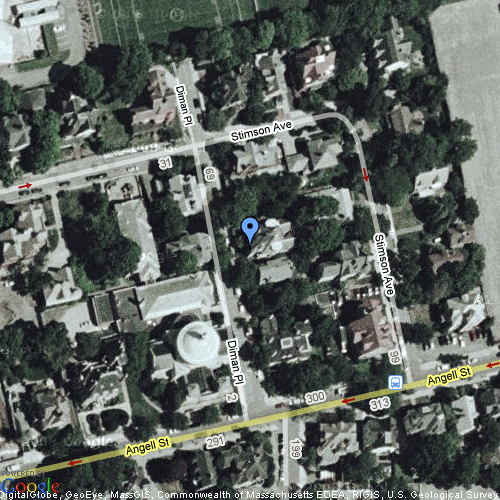
Our home for a few months in Providence, Rhode Island.
Hauled out and almost ready to go
December 17, 2008

Sabbatical III was hauled out today. A few more repair and maintenance items and then we are ready to return to the US. The thick schools of big blue jellyfish were a concern this morning as they twice got caught in the water intake that cools the engine and clogged it. But we made it OK with a little help from our friends. We will fill in the details later.
M.
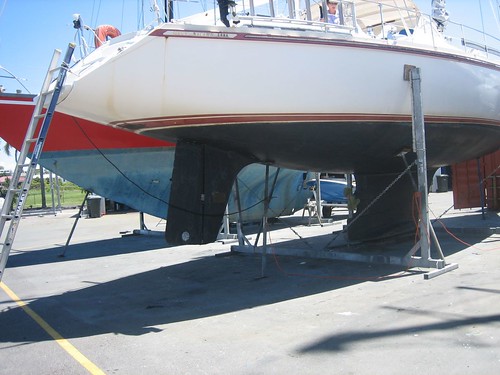
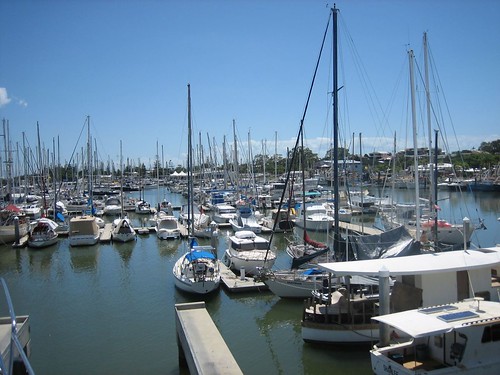


Something’s happening at the zoo
December 13, 2008

We are still in the Scarborough Marina getting the boat ready to be stored for the season. She gets hauled next Wednesday and we leave for the US two days later. We have been able to visit with friends and tour some of southeastern Queensland. Most of these photos are from Steve Irwin’s (the Crocodile Hunter) Australia Zoo. We went with our friends from Tackless II (Don and Gwen) and Whistler (Duncan and Robin). Tackless II brought Joshua, their grandson’s teddy bear, and took photos of Joshua meeting the animals.
Mark
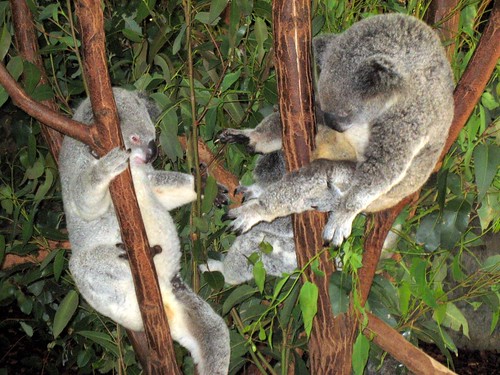

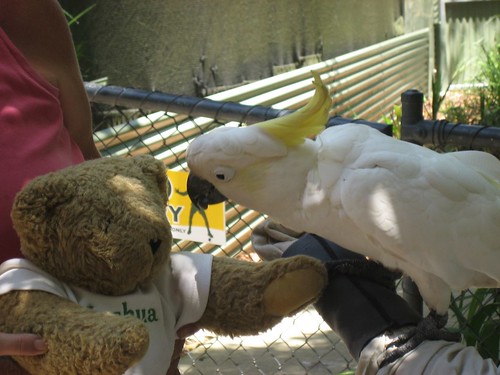
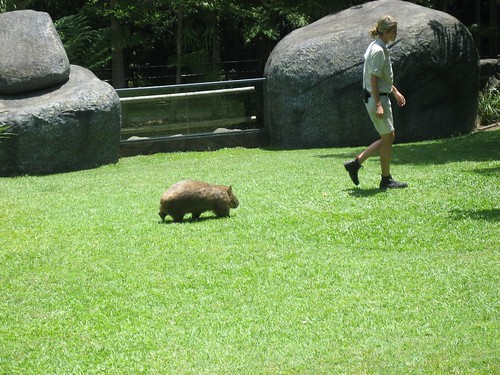
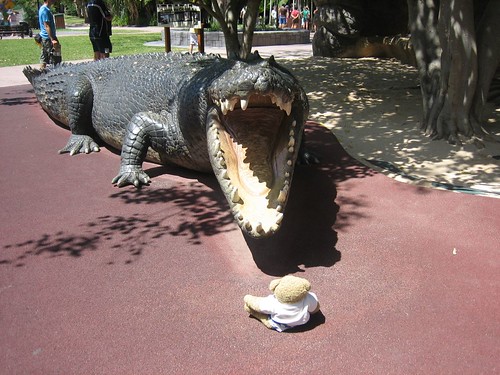
Down the river and up to Scarborough
Yesterday we left Dockside Marina in Brisbane and sailed to our final destination of this season – Scarborough Marina up in the small town of Redcliffe. It took just a few hours – a two hour motor down the river from Brisbane to Moreton Bay and then another 2 .5 hours north to Redcliffe. The Brisbane River was still filled with debris – logs, thick foliage, tires and bottles – from the 3 storms the previous week and we had to proceed very cautiously down the river. I stood on the bow as Mark steered and tried to alert him to any large submerged objects so he could veer around them. Our friend Jim on “Cardea†– who is sailing alone- followed closely behind us. As much as we enjoyed Brisbane, it was nice to leave the brown river behind us and head up into the cleaner water of the bay. Scarborough Marina is quite large – there are about 240 boats here – many of them belonging to Aussies – but a good number belonging to cruisers like us who are either leaving their boat here for the season – or just stopping off for a few months and touring the country. When we were about a mile from the marina we started seeing some blue blobs in the water and thought at first that there was garbage in the water – but it quickly became clear that it was not garbage – but very large, and abundant blue jelly-fish. There were thousands of them. They are actually very beautiful, but a bit creepy. We certainly won’t be doing any swimming here. There are also many sharks here – and not the kind you want to go for a swim with!
There is a terrific seafood market just ¼ mile from us and all the marine facilities that we need to take care of our end of the season boat maintenance. Mark has a huge list of boat maintenance projects we need to get through before we leave.
Happy Thanksgiving and happy birthday to Mark and his twin sister Frannie!
L.
Hazards to navigation
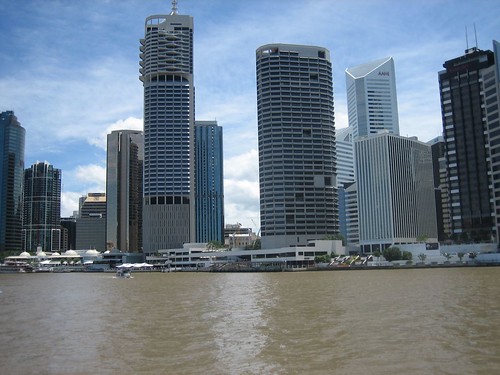
- Brisbane skyline
November 22, 2008
We are still berthed at Dockside Marina located in the middle of the city of Brisbane. Towering over us is a set of 25 story luxury condominium/apartment buildings making up a large new development called Dockside. There are still some buildings under construction and units in the newest buildings are still for sale. All of this is located on a narrow peninsula in the Brisbane River called Kangaroo Point. The central business district is right across the Story Bridge, or, more conveniently, a ferry stop away. We bought a weekly Tranlink ticket that provides for unlimited use of the ferries, buses, and train within the central city. At AUS$23 each, it is quite a bargain.


Downtown is dominated by tall modernistic skyscrapers. There are restaurants and food courts everywhere. The densest concentration of shops is on Queen Street, a pedestrian thoroughfare with outdoor cafes and every imaginable type of store, including two underground supermarkets. On Thursday and Friday, we bought take-out sushi on Felix Street and then walked three blocks to the Botanical Gardens that front the river. After dining at a picnic table in the shade, we walked the length of the park and then crossed the river on a pedestrian bridge (Goodwill Bridge) to the Parklands, a beautifully park that stretches out for at least 2 kilometers along the south bank of the river. The Parklands contains restaurants and cafes, gardens, Griffiths University, the Performing Arts Complex (Concert Hall for the symphony orchestra, opera, and dance companies), the Museum of Art, an artificial swimming lake with a sand beach, and a gigantic Ferris wheel, among other things. The beach was crowded with mothers and children at one end, and teenagers at the other. We took a ride on the Ferris wheel, which provided us with an excellent view in all directions from the comfort of an air conditioned gondola.

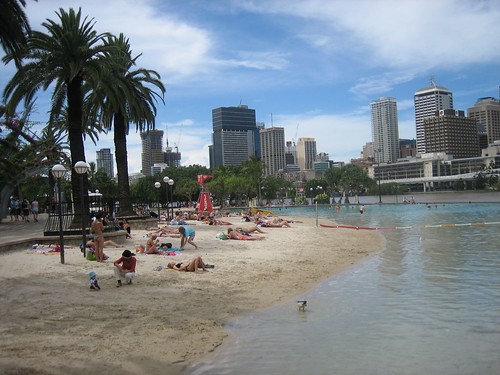
The weather has been hot and humid since we arrived. As we noted in our previous post, the most damaging storm in 25 years blew through Brisbane a few hours after our arrival. There have two more severe storms in the past few nights. Having three storms in five days is very unusual for Brisbane, we have been told. The rain was torrential and by the time the third storm hit on Thursday night, there was serious flooding and wind damage. Roadway underpasses flooded trapping cars, roofs were ripped off houses, and there were power outages. The Brisbane River rose and flooded its banks to the north and west of the city. The river turned chocolate color and by Friday morning masses of debris – tree branches, logs, masses of green foliage, and discarded junk from the river banks upstream – started to fill the river. At the ferry landings and marina and other places where protrusions stick out into the river, this debris completely covered the surface of the water up to a foot thick, and birds walked out onto it. In the evening we heard something whacking the hull of Sabbatical III and went out to find that a large log had wedged between the boat and the dock and a huge mass of debris had collected behind it. As Laura held the flashlight, I used a large pole with a hook to move the debris away from the boat. Local boaters told us that they have never seen anything like this since the great flood of 1974.
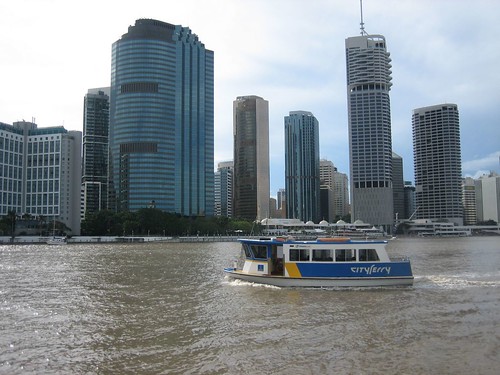
Usually we are awakened in the morning by the wakes of the many ferries bringing people into the downtown area. This morning we slept in, undisturbed by wakes. It turns out that the river debris formed a hazard to navigation and all ferry service was cancelled quite suddenly at 6 pm yesterday (Friday) evening , just after we took the ferry back to the marina, and will not resume until Tuesday morning at the earliest. We had to use buses to get around today. The river is now eerily quiet, and the lack of roll from boat wakes which makes our time on Sabbatical III more pleasant. Our planned Monday morning departure for Scarborough Marina is unlikely to occur. With the river as it is, we would either damage the prop in a collision with some floating object, or overheat the engine as debris clogged the cooling water intake. We have had our departures delayed because of the weather many times, but never before because of debris in the water. On the bright side, this is a great town to get stuck in for an extra day or two, and all of this rain marks the end of a period of serious drought in Queensland. It is against the law to use a hose to wash a boat or water a lawn. Perhaps that will now change.
M.
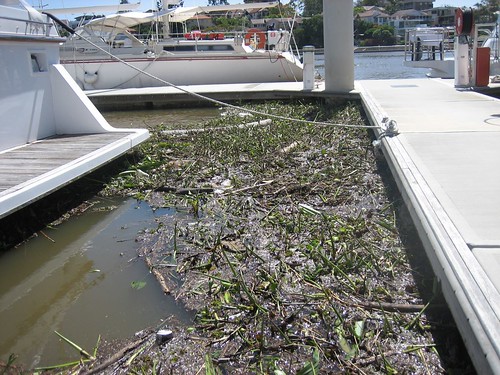
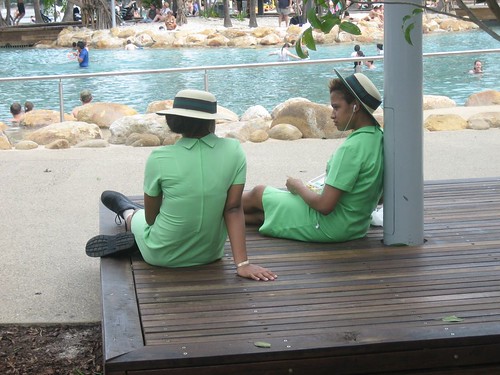

Troops clean up after worst storm in decades!
This was the headline in the Brisbane newspaper on Monday November 17th, the day after we arrived. As we approached Moreton Bay in Australia (on Sunday) where we were to make our first landfall since leaving New Caledonia, we heard on the radio that there was a “high wind†advisory for the area . We had known that a storm was predicted for the coast of Australia on Sunday, and had timed our departure from New Caledonia six days before, calculating that we would arrive before it hit . The storm was not supposed to arrive until late in the day and we knew we would arrive by mid-morning so we were not overly concerned about it. It was a gorgeous, hot and sunny day and our entrance into Moreton Bay was lovely – the huge bay was filled with kayakers and sailboats and also big cargo ships waiting to either drop off or pick up cargo from the docks at the Brisbane River. It was not terribly windy and the skies were perfectly clear. We got to Rivergate Marina and immediately were boarded by the check-in officials from quarantine, customs and immigration. Everything went smoothly and they were all really friendly and professional, despite all the rumors we had heard from other sailors that Brisbane had extremely tough check-in procedures. It couldn’t have been easier. Then about 4:00 p.m. as we were just resting and relaxing after our long passage we saw the clouds start to darken, and by 5:00 p.m. the winds had increased to 30 knots, it was pouring and there was just an incredible amount of lightning. Huge jagged streaks came down from the clouds for the longest time with driving rain and gusts up to 35 knots. Finally the lighting stopped, but it continued to rain all night . We just slept through the night, however, being exhausted from the trip and also feeling all safe and secure in our slip. It was not until the next day that we found out that we had gotten there just in time for the biggest and most damaging thunderstorm in Brisbane in the last 25 years! Here is a quote from the newspaper: “ Soldiers, low security prisoners and police recruits will today help to clean up Brisbane, which was declared a natural disaster area after it was lashed by one of the most damaging storms to hit the Queensland capital in a quarter of a century.†Wow – we felt very lucky that we had not been out at sea when it hit!
We spent only one night in Rivergate Marina and then moved six miles upriver the next day to the Dockside Marina. Dockside is right in the center of Brisbane, on one side of the Brisbane River which is lined with dozens of very beautiful condominiums, manicured lawns and gardens, walking paths, several restaurants, and best of all, a ferry dock right at the marina that takes you across the river in 4 minutes to downtown Brisbane. It is a very large city – just jammed with commercial property of all sorts – banks, businesses, restaurants, coffee shops, malls within malls and every kind of retail shop you can imagine. There is a pedestrian mall downtown that stretches for blocks and walking along it at mid-day is like walking through Boston. It is jammed with people. Ferries run up and down the river taking people back and forth to wherever they are headed and there are efficient well marked bus routes and all sorts of public transportation. It is fun to be in such an urban environment for a change.
When we moved the boat up to the Dockside Marina from Rivergate we were a little worried about how we would tie up to the dock. Normally there is someone at a marina who can help you by grabbing your boat lines and tying you up to the dock. It is hard for us to do it alone as Mark has to steer the boat and that leaves just me to leap off the boat and tie off 4 lines quickly before the boat drifts off and knocks into neighbors. (Luckily we are rarely at a dock). This marina is mostly for locals who are at work all day and the woman who works in the office told us she can not help with lines. The weather forecast was for strong winds, and there are strong currents on the river which would have made bringing it up to a dock unaided even more difficult. We were in luck though, as our neighbors on the dock we were leaving were actually crew members (on a large and beautiful 68 foot Oyster). They, Lorenzo (Italian) and Candia (German) were nice enough to drive up to the Dockside Marina at the same time as we were sailing up, and then met us on the dock to help with lines. It turned out to be especially helpful because the slip that had been assigned to us had another boat in it when we arrived and we did not know where to bring the boat. We also could not easily contact the office as the woman who runs it does not moniter a VHF. Lorenzo found her by using his cell phone, got us another slip assigned, and then he and Candia walked down the dock and grabbed our lines and easily tied us up. What nice people we meet along the way!
It is very strange how some things don’t work very well here though. We have been trying to get a simm for our cell-phone for two whole days now and even though the downtown area is filled with mobile phone shops, we still do not have a working phone. Today we got a simm from Vodaphone – one of the two major suppliers here – and after spending 3 hours in the office – providing them with every piece of information possible (including our passport numbers!) we still do not have a working phone. They insisted on us having a local phone number before they would issue us a cell phone, so we gave them the number of the marina. How can you have a number here if you are getting a phone for the first time? When, after 3 hours, we were still there in the office and the simm did not work, we asked them to simply refund our money so we could go on our way. Unbelievably, they refused saying they do not make refunds. Even when it was clear that it was their product that was not working, and we never even left the office or were able to use the phone for one minute, , they refused, saying that once they sell you something it is “not refundableâ€. Amazingly frustrating. So, right now we are out $60 for a simm and a pre-paid phone plan that just doesn’t work. We are hoping that maybe the system will accept us somehow later today and we will be able to use the phone. We could get a cell phone chip that worked in all of the very undeveloped countries we have visited (like Vanuatu where most of the cell phone users don’t even wear clothing), but here in Australia it is all a big mystery.
At least we can use the internet from the boat here, and tomorrow we will get a regular old phone card and be able to use the pay-phones on shore.
No worries, mate.
L.
Safe arrival in Australia
It is Sunday, November 16th and we arrived at the Rivergate Marina outside Brisbane at about 1:00 p.m completing our 830 nm passage in 6 nights. The last day of the passage was great – nice wind and smooth seas. All in all a very easy passage. We would have loved to have a little more wind, but with wind you get more ocean swell and therefore more discomfort, so I have to say that I was quite happy with how the trip went. We probably motored about half of the 6 days. We are both very tired now as we did not get enough sleep on the trip – just short stretches – and what we need right now is a quick dinner and a long uninterrupted sleep.
Good night. More tomorrow.
L.
Day 5 at sea
Sailing from New Caledonia to Brisbane, Australia
Friday, November 14th, 2008
03:30 UTC (14:30 local time)
Position:
S25.25
E 156.59
Winds: light and variable
Seas: light
Speed under sail : 4.2 knots
Forecast: more of the same
We are now more than 600 miles from our departure port of Noumea, New Caledonia and only 200 miles away from our arrival port in Brisbane, Australia. At our current pace we expect to arrive in Brisbane on Sunday. It has been a slow, but comfortable ride. The forecast we had for light winds for most of the week ended up being light winds for the entire week. There is often not enough wind to keep the sails full so we have had to motor at least half of the way.
The engine noise and smell gets annoying and we are trying to sail as much as we can even if it means moving along at barely 4 knots (a good speed on Sabbatical III for a passage like this would be more like 7 knots). Days have been mostly clear with phenomenally blue skies and a deep blue ocean. It is warm. There is some ocean swell which keeps the boat rocking a bit, but nothing compared to our trip last year when we banged our way down to New Zealand with strong winds, storms and big seas.
The big full moon keeps it bright as day at night except when the occasional rain shower moves through. We take turns sleeping so that someone can look out for ships and make sure the sails are set right. So far we have seen two large ships, but both were several miles away. We have daily radio contact with 3 other boats. We are eating well on the boat, but will be out of all fresh food by the time we arrive. Good thing too as Australian quarantine is known to take away most everything that is not canned.
So, all in all, things are good.
L.
Passage to Brisbane: Day 3
November 13, 2008
We sailed all night last night in light/moderate winds and rain showers. Today we are mostly motoring as winds are less than 7 knots since noon. The swell has increased to about 6-7 feet.
All is well but we are wishing for wind.
Position at 4:25pm New Caledonia time:
S 24 degrees 41.56 minutes
E 158 degrees 55.25 minutes
Course 240 degrees magnetic, motoring at 6 knots. Winds west at 4 knots, seas 2.0-2.2 meters in swells.
M.
Passage to Brisbane: First two days
November 11, 2008 10:20 am local time
We left the fuel dock in Noumea at 12:30 pm Monday, well ahead of our planned Tuesday morning departure. There is a storm forecast to come up the east coast of Australia from the south that should reach Brisbane late Sunday night. We wanted to be sure that we were in Bribane before the storm arrived, so we left early.
In spite of the forecast of light winds for Monday, we had a terrific sail coming out of New Caledonia. As soon as we left Petite Passe and entered the huge lagoon of New Caledonia, we were making 8.5 knots under sail. We entered the ocean through Passe Dumbea, about 10 miles away. The ocean swells were light and the wind was great. We kept up 8.0 – 8.5 knots in flat seas until 10 pm. Then the wind just died. We motored Monday night in clear skies and an almost full moon.
Yesterday (Tuesday) morning, we set poles and set our genoa to port, but when we tried to set our ballooner (spinnaker) to starboard the head of the sail ripped, rendering it unusable. It would have been the perfect sail for much of the day. We improvised by sailing wing-on-wing with the genoa and main. We had to motor a few more hours during the day, but just before sunset the wind came up a bit and we were able to sail all night, although at only 5 knots. The wind has moved forward of the beam this morning and we are motor-sailing in 6 knot winds from NNW and seas less than 1 meter. Skies and clear and the air is warm.
Our position at 10:30 am Nov 11 (Local time) is:
S23 degrees 41.93 minutes
E161 degrees 51.43 minutes
We are making 6.3 knots on a course of 239 degrees magnetic.
The other good news is that I cannot find any trace of water in the transmission, so the repair we undertook in Noumea seems to have fixed the problem.
Both Laura and I heard whales surface near the boat last night but by the time we looked for them, they were gone. I wish they would stay and visit with us for awhile.
We left Noumea just two hours before Cardea with Jim and Kevin aboard, and 20 hours before Sol Searcher with Ray and Peggy. We have an informal SSB net with Carea and Sol Searcher every evening. Magnum (Uwe, Anne, and Kara) joins in the net as well even though they are still hanging out in Iles des Pines waiting for more wind.
M.
Departing in a few hours for Brisbane, Australia
November 10, 2008 (0900 local time)
We will leave Noumea for Brisbane, Australia in about two hours. There is now fuel at the fuel dock and a bit of a weather window. This window will not last long, so we need to depart today. The passage is about 830 nautical miles (950 miles) and will take about 5 1/2 – 6 days. The winds are forecast to be light/moderate to start, becoming light and variable, then becoming moderate to strong at the end. There will be some wind shifts as we pass through a area of weak low pressure. We will send updates along the way.
M.
Checking out
November 8, 2008
We are still berthed at the Port Moselle Marina in Noumea, New Caledonia, waiting on the weather. It appears that we may leave for Brisbane, Australia on Tuesday morning. We have been waiting for a low pressure system to come up the eastern coast of Australia and dissipate, and for another area of low pressure to the west of us to move away. Both events now seem likely.
We were going to do the checkout from New Caledonia on Monday. Fortunately, our friends on Magnum decided to check-out yesterday (Friday) morning and then came back to tell us that they learned that Monday and Tuesday were public holidays and all of the offices would be closed until Wednesday. So, we canceled our lunch date and immediately engaged Rikki of the boat Temerious to drive us in the appropriate order to the three offices (Customs, Immigration, and Port Captain) required for clearing out. She also stopped at the Casino supermarket so we could pick up some heavy items. With the four day holiday, we are clear to leave anytime through Wednesday without having to contact any authorities. I also emailed our details to Australian Customs and Immigration, as required. Our plan is to leave the marina tomorrow morning, purchase duty-free diesel (as a departing foreign vessel), and then sail to one of the small motus near the Passe Dumbea , our planned exit from the reef that surrounds the big island (Grand Terre) of New Caledonia, and anchor out until beginning our passage to Australia Tuesday morning. We walked over to the fuel dock just before it closed this evening to learn the lay of the land and found out that they are out of fuel! Two large motor yachts came through and bought all of their fuel. The woman at the fuel dock said that they ordinarily get a fuel delivery on Monday morning, but this is a long holiday weekend, so that it not certain. Even though it is likely that the fuel onboard Sabbatical III is sufficient for our passage to Australia as the winds are forecast to be good, I hate to leave on a long ocean passage without a full tank. Tomorrow, we will see if the yacht club can sell us duty-free fuel, if not we may have to stay in the marina until the fuel dock gets a delivery. I am hopeful that we will make our Tuesday morning departure schedule since weather windows are scarce around these waters and we have been waiting 2 ½ weeks for this one.
M.
Waiting for wind
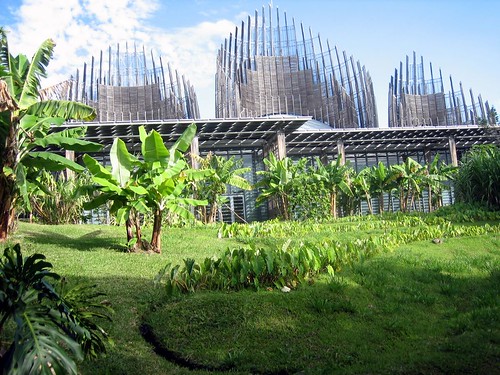
October 31, 2008
We are still in Noumea, waiting for the right wind to blow us to Australia. The forecast suggests we may be here for a least a few more days.
Yesterday we went to the beautiful Tjibaou Cultural Centre which celebrates Kanak culture.
M.
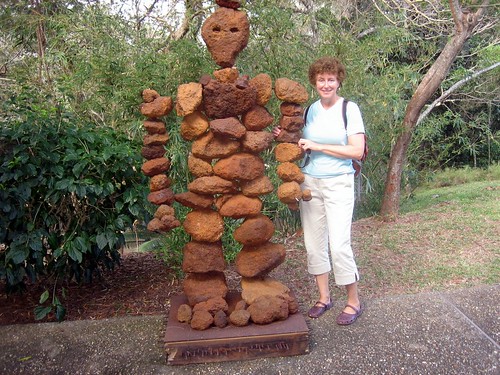
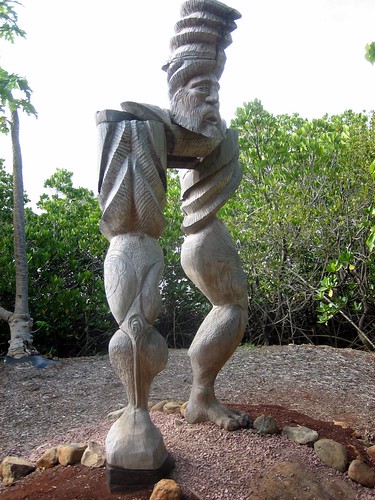
Our photos from the last few months are now available
Some of our photos from the past few months are now available for viewing. Just click on the links below. Each set of photos will open in a new browser window.
Photos from Vanuatu:
Plus a short new video of dolphins chasing Sabbatical III on the way to Noumea is available on our video page.
Preparing for the passage to Australia
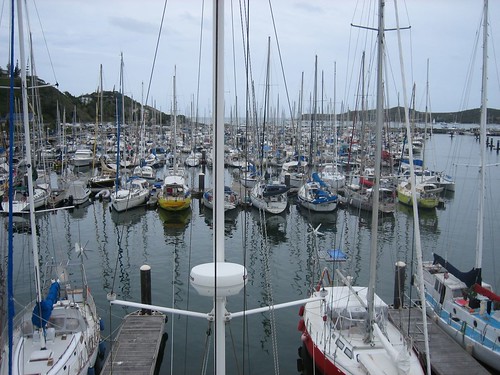
October 28, 2008
We remain at the Port Moselle Marina in Noumea, New Caledonia. We have completed almost all of our preparations to go to sea and now just wait for a weather window for the passage to Australia. The earliest we can leave is Thursday morning since we have not yet done the check-out, which involves stops at Immigration, Customs, and then the Port Captain. A wonderful weather window opened on Saturday and resulted in the departure of many boats including most of our friends. There is a big fat area of high pressure in the Tasman Sea and no low pressure for hundreds of mile. It is not clear that this good weather window will last until Thursday, and if not, we will wait patiently in Noumea.
The reason that we could not leave with the others is that we had an important repair to make on Sabbatical III. After we arrived in Iles des Pines, I noticed that oil in the Amel transmission was suddenly mixed with sea water. Amel’s like Sabbatical III are unusual in that they do not have a prop shaft. Instead, power from the engine is transmitted through a set of gears that are contained in a tube located in the keel. This tube is filled with about 2.5 gallons of oil and rises into the engine compartment to a point above the waterline. The prop itself is attached to the keel. This is Amel’s own design and it has various benefits. The drawback of this system is the possibility that seawater may find it’s way into the oil-filled gear tube as the prop turns. To reduce that risk, Amel’s have three redundant seals on the bronze bearing for the prop. These seals and the bronze bearing need to be changed every two years or so as they can wear out. The bearing and seals on Sabbatical III were changed just before we were relaunched in New Zealand in May, and so are quite new. Nonetheless, the presence of water in the oil indicated a leak and the only logical place for the leak is where the prop turns in the bearing at the bottom of the keel.
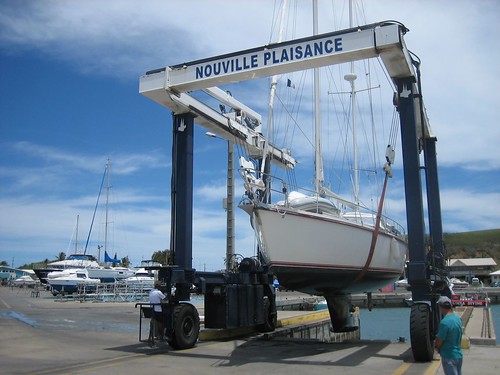
When we arrived in Noumea, I found a marine repair specialist, Monsieur Caubert Gerard, through the Cercle Nautique Caledonien, the yacht club of New Caledonia. Gerard and his associate Patrick met us at the marina on our first day in Noumea. They took us to Nouville Plaisance in their truck, the marine repair facility on the far side of the bay, to book a haul-out, and then we all went out for lunch in the port district. We were hauled yesterday morning and it took about 3 hours to replace the bearing and the seals. Fortunately, I had two spare sets of bearings and seals aboard Sabbatical III or else we would have to have them shipped to us from Amel in France. Gerard speaks only a little English so Laura translated my understanding of how the prop drive system must be disassembled. That understanding came from a detailed English-language document written by an American Amel owner and posted on the Web. In preparation, Laura researched mechanical and marine terms in French in her “French for Cruisers” book. The boat was back in water a bit more than three hours after she was hauled. Things seem fine but we will not really know until she has been running under engine power for some hours. The need to haul the relaunch the boat for this repair made it fairly expensive but we are quite fortunate to be in a place with a yacht haul-out facility (for example, there is none in places like Vanuatu, Tonga, and Samoa), and to have an experienced person like Gerard around for the job.
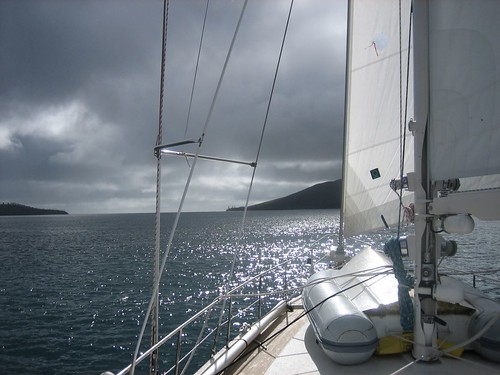
The hardest part of the day was getting back into our berth in the marina. The wind kicked up while the boat was “on the hard” and was blowing 25-28 knots when we were put back in the water. Typically, it is pretty easy to back Sabbatical III into a slip by using the bowthruster, a small electrical propellor in the bow of the boat that turns the bow to port or starboard. To steer in reverse, I can only use the bowthruster as the rudder is pretty useless then. Yesterday the wind was blowing so hard across the bow that the bowthruster was not powerful enough to fully counter the big gusts. I had to abort my first attempt to back into the slip as we were almost blown onto the boat that shares our double-wide berth. I made it on my second try thanks to a team of fellow boaters than ran out to help catch the lines that Laura threw, and then pulled the boat into place as I worked the bowthruster as hard as I could. We were both frazzled by the experience. In hindsight, we should probably not have even tried to come back into the marina under those conditions.
To our delight, Regine and Gerard of the French boat Galdus came into the marina and are berthed just 30 feet away from us. We have not seem them since Tonga last year except for a very distant wave in Lifou a few weeks ago. From that distant wave we knew they were somewhere around New Caledonia. They served us a wonderful lunch on Galdus today and we had time to catch up with each others adventures. They also enquired about Benjamin since they got to spend time with him when Ben visited us in Tonga last year. This is the second circumnavigation for Regine and Gerard, their first was 25 years ago.
Plans
When we leave for Australia, own plan is to sail to Brisbane (Queensland) and do our formal check-in at the port-of-entry at Rivergate Marina up the Brisbane River. If the wind does not cooperate, we may instead make landfall at Bundaberg, about 120 miles to the north. This is a passage of about 830 nautical miles and should take us five and one-half to six days. From November until next May, the boat will live at the Scarborough Marina in Moreton Bay, about a two hour sail north of Brisbane. She will be in the water until mid-December and then get hauled for dry storage for about four months.
M.
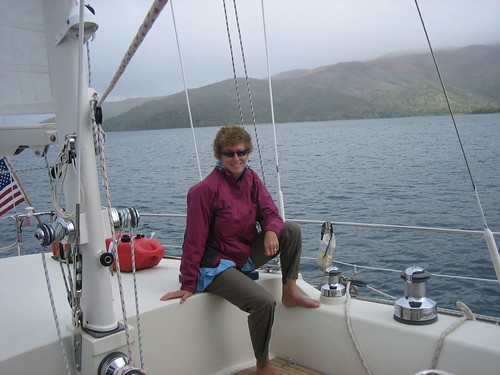
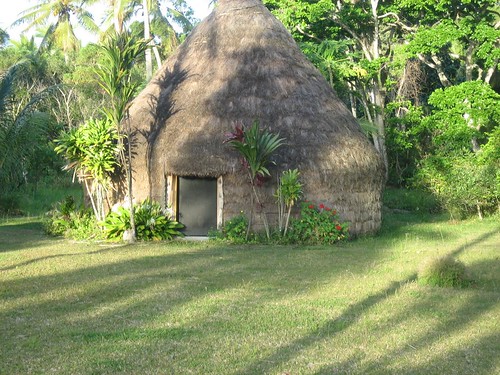
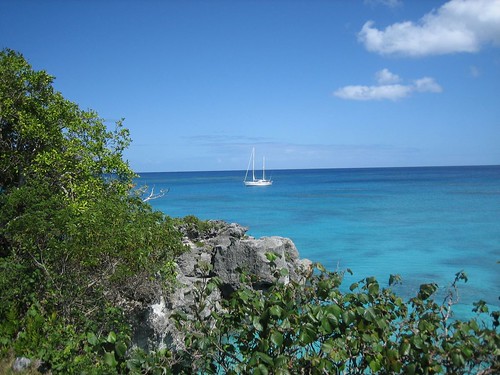

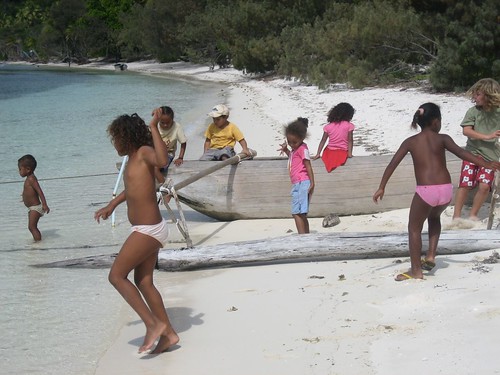
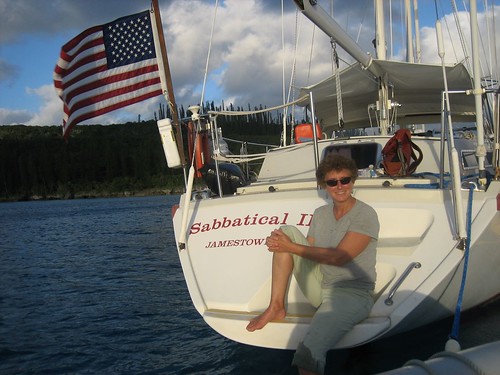
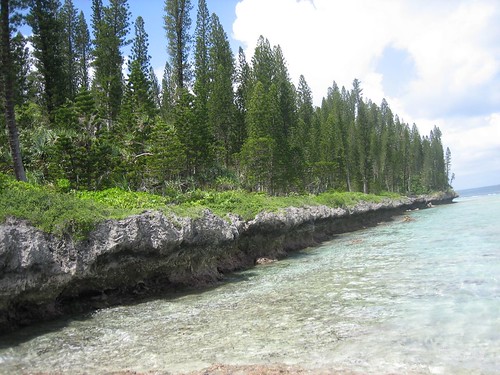
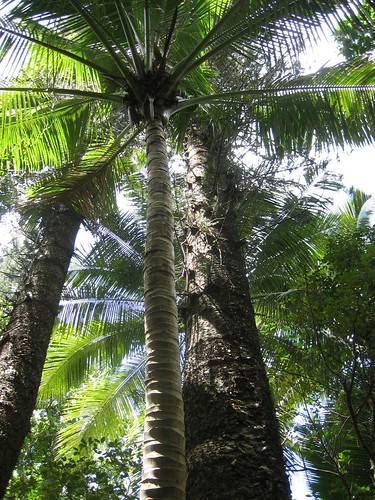
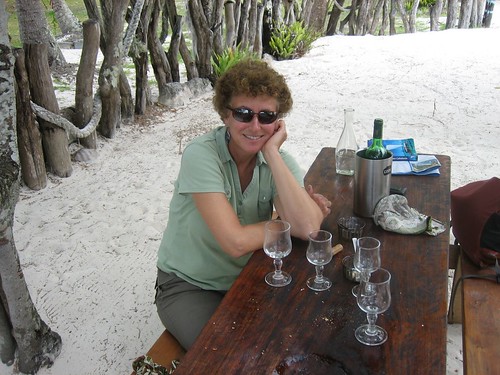

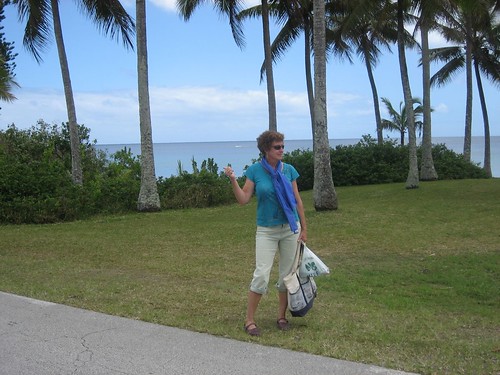
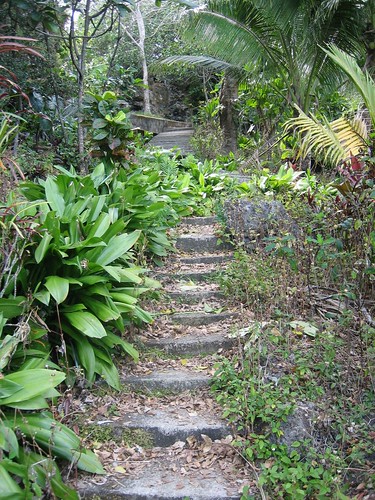
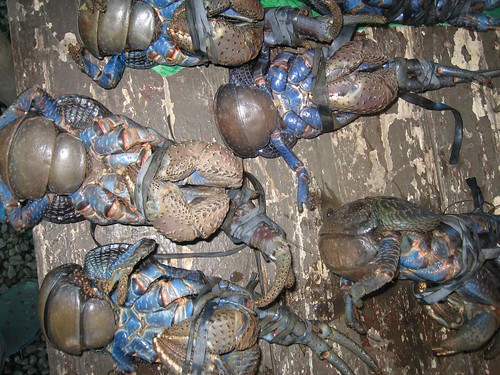
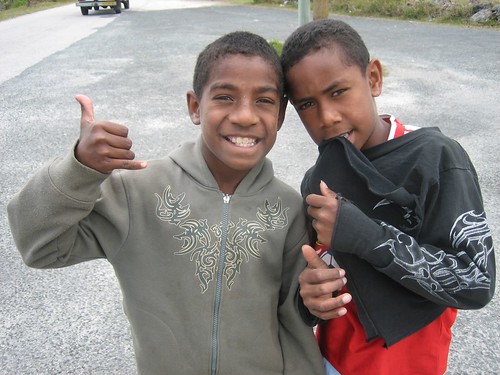
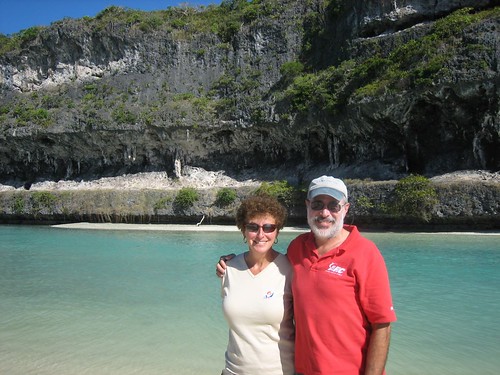

Noumea – New Caledonia
It’s Friday, October 24th and we are now in Noumea, the capitol city of New Caledonia. We are on a dock for the first time since we left Opua, New Zealand six months ago. We left Ile des Pines a week ago and had a beautiful 45 mile sail to Baie Uie where we spent 2 nights. The sail took us past a few reefs and tiny islands (all accurately charted) and through a gorgeous channel (Canal Woden) which flows between the mainland of Grande Terre (the name used to describe the big island of New Caledonia) and the outlying island – Ile Ouen. We had heard that the chop and the currents in the channel could be daunting, but the winds were light and we had the current running with us and it was fantastic. Really a beautiful passage.
The weather turned nasty once we tucked into Baie Uie and we just stayed on the boat, watching movies for a day, waiting for the weather to clear to finish the sail to Noumea. On Monday we sailed in to Port Moselle in Noumea . A couple of large dolphins swam and dove around the boat for a while as we neared the entrance to the harbor. Noumea is a busy place, with hundreds of sailboats at the docks and out in the anchorages. It is a good sized town – much bigger than any we have been in on this trip. We keep running into other sailers that we know – which is a lot of fun. We have a couple of friends here who we have been trying to catch up to all year, but our paths never crossed until now.
We are really enjoying being on the dock – there is a fantastic fruit and vegetable market right next to us – coffee shops, patisseries, restaurants, stores. It is very much a French island and the food is all wonderful. We could easily eat every meal out if it weren’t so expensive! We have been visiting with friends, doing boat chores, doing a little shopping, and getting ready to have the boat hauled on Monday in order to do a small repair.
We will probably be heading to Australia within 10 days!
L

Touring Ile des Pines
October 13, 2008
Soon after we posted our last blog, we left Baie de Ouameo for Baie de Gadji in the northwest corner of Ile des Pines. Baie de Gadji is strewn with small islands and reefs that form a protected basin, almost like a lagoon, in a beautiful setting. The only problem is that Sabbatical III draws too much water to enter the basin. Instead, we inched our way along the southeast cost of Ile Moenoro until we had less than a meter of water under the keel, and dropped our anchor in a spot less than 500 meters from the basin. The spot we anchored in is not well protected from strong tradewinds, but is perfect for light winds, or winds from the north or west. The forecast called for winds clocking around to the north and then west, which they did, so it was a perfect place to spend four days.
The snorkeling was among the best of the season. As the winds fell to less than 5 knots and clocked around from the north, we were able to snorkel on the fringing reef where ordinarily large swells would break. We snorkeled over 100 meters of shallow coral alive with small fish to reach a drop-off with a wall of coral descending at least 30 meters into the sea. Along the drop-off we saw lots of larger fish including a blacktipped shark, sting ray, eagle ray, and big groupers and trevally, as well as a sea turtle.
In the shallow protected basin, we found only one vessel, Cool Change, one of the boats that was with us in the Port Vila to Ouvea rally. As a catamaran with retractable dagger boards, Cool Change needs only a meter of water depth. They reported that catching trevally (fish) was easy from the dinghy, and showed us one they had just caught, so Laura and I gave it a try. We had no success, although it was fun to try. I think my lures are all too large — they target large pelagic fish like tuna rather than the smaller species that live in lagoons. (Ciguatera is not a problem in this lagoon.)
After four days in Baie de Gadji the tradewinds came back in force, and our location became less advantageous. Moreover, the chop and swell made snorkeling difficult. So we headed back to Baie de Ouameo (5 miles away) in order to arrange a car rental (our first of the year) from the Hotel Kedjoe. Our first priority was to buy fresh fruit and vegetables from the market in Vao, which is held only on Wednesday and Saturday. We got our car at 8 am Saturday, the earliest time that it was available, and drove along the coastal road to Vao where we ran into our friends from the Dutch boat Joanne whom we had not seen since Samoa. We got to the market at 9 am at which time the fruit left for sale consisted of a single pamplemousse. The pamplemousse was still available because of the small worm hole on one side. We were desperate so we bought the pamplemousse (no discount for worms). The only veggies left in the market were unappetizing green tomatoes, not counting yams and sweet potatoes. We had brought a big backpack and some cloth bags that we intended to fill with fresh fruit and vegetables from the market, and all we got was a single wormy pamplemousse. At the grocery store in Kuto we found some New Zealand apples, and in the boulangerie we found some oranges from Mare. But local produce was not to be found.
After a coffee on the beach at Kuto, we drove to Baie d’Oro on the northeast coast. Our friend Sebastien from the boat “Rayam”, who shared the anchorage with us in Mare, told us about this fabulous restaurant on the beach — Restaurant Le Kougny. To get there, you park in the lot of the Hotel Medien, the only 5-star hotel on Ile des Pines, cross a tidal river to an island, and follow a footpath through the woods to the other side of the island. There, on the beach, is a small campground with some rough hewn tables set under the palms with a beautiful view towards a lagoon and reef. That is the Campground/ Restaurant Le Kougny. We had called the day before to order our meal, which is required. The choices are langouste (lobster), escargot (an Ile des Pines specialty), and fish. We had ordered the lobster, as did almost all the other dozen or so guests. It was an unforgettable meal. The lobster was large and sweet and we spent an hour finding meat in various lobster appendages. A full bottle of chilled white wine encouraged patience. The meal came with a small salad, rice, fruit salad (mostly canned!), and of course, lots of French bread.
After lunch, we strolled through the grounds of the Hotel Meridien and ran into Randy and Sherry of Procyon, whom we had not seen since Ambrym Island (Vanuatu). Randy had been hospitalized in Noumea after stepping on coral and getting a very bad infection. He seems to have made a complete recovery. We then drove to the Grotte de La Reine Hortense, a famous cave in the interior of the island. I guess we are not much enamored by caves even though this one is impressive. We also visited the grounds of the prison colony that took up nearly one-half of the island. After the uprising in Paris in 1870/71 (Commune de Paris), those involved were either executed or deported to a new prison colony at Ile des Pines. The French also sent rebellious Algerians and Kanaks from Grand Terre to the Ile des Pines prison colony. The prison finally closed in 1911 and the land returned to the local people. We visited the striking cemetery where the Paris Communards were buried in unmarked graves.
We are now back in Baie de Gadji. It is a day of squalls and rain so we are staying on the boat. We are hoping that it may clear up but a new weather forecast suggests we may have squalls for a few days. Well at least we have a bit of fruit to ward off scurvy.
M.
Leaving Mare and passage to lle des Pines
October 5th
On our last day in Mare – Friday the 3rd of October – we decided to hitchhike back to town one more time. We had one important mission to accomplish and that was to dispose of the garbage that has been accumulating on board since we left Port Villa, Vanuatu – 3.5 weeks ago. When you are at sea you can dispose of all food and paper, plus glass bottles and tin cans. You are never supposed to throw any plastics at sea, and it is amazing how much of that stuff starts to accumulate on the boat – plastic food wrapping (stinky from fish or meat), plastic bottles, milk and juice containers, Styrofoam egg cartons, etc. In the other Loyalty Islands (Lifou and Ouvea) – the towns would not accept any garbage from sailors. It is just too expensive for them to dispose of it. In Mare, however, the tiny little town was just filled with large garbage dumpsters and there was no problem with us dropping it off there.
It says a lot about life on a boat when you can get a great deal of pleasure from simply throwing away some old stinky garbage bags – but it’s true. We felt great about it. The only problem was trying to mask the embarrassing smell from leaking out of the bag, stuffed in a large backpack, as Mark held it on his lap during our brief car ride to town. The local who picked us up probably just assumed that we smelled like all other sailors he had met.
After disposing of the garbage, we walked over to the marketplace and found that there was a great deal of activity there. Lots of people, a live band, and a huge barbeque grill set up. It was a real party. It turns out that there is a local high school and on Fridays (or at least this Friday) they had come to town to make and sell food to one and all. Some of the teachers had formed a band and they were singing a variety of French and English songs. They were excellent. Besides grilling fish and chicken, the kids and their profs were making French fries and selling pastries. We tasted a little of everything and then loaded ourselves down with fresh tomatoes and went back to the boat to prepare for the next day’s passage.
We left Mare on Saturday morning at 5:45 a.m. It is a 70 mile passage from Mare to the Passe de Bumbu at Ile des Pines and we wanted to time the trip so that we would arrive at the pass right at low tide which was going to be at 4:20 p.m. The currents going through the passes here are very strong and it is best to time your entrances for the slack water that occurs at either high or low tide. It turned out to be a terrifically fast and easy passage – the wind was 20 knots right on the beam and we were flying along at 8 to 9 knots. We were going so fast, in fact, that we had to reduce sail drastically to slow down – otherwise we would have arrived at the pass way too early. As it turned out we reached the pass at 2:30, almost two hours before low, but it was clear that we could enter without any problem.
So here we sit in Baie de Ouameo in the famous Ile des Pines of New Caledonia. We are the only boat in this anchorage and we have not left the boat all day. As a matter of fact, it ended up being another “Mark fixes another critical system” day, as the first thing we noticed when we arrived was that the toilet in the aft head was not working. The seawater flush pump failed so the head could not be flushed. Fortunately, we had a replacement pump on board. The replacement pump would not fit without some alteration to both the electrical and plumbing connections, so it took longer than it might have, but now the head works as good ever. Life is good.
L.
More Mare
October 1, 2008
We are still enjoying the island of Mare . The anchorage is beautiful with big pine trees on a high plateau all around, and caves in the coral wall by the sea. There only other boats here are two small French boats out of Noumea with young people on them. One boat has Sebastien and Elsa, both nurses at a Noumea hospital, and the other has Stefan, an urban cartographer and friend of Sebastien and Elsa. We had the three of them over to Sabbatical III yesterday evening for wine, baguette, brie, and other goodies that we bought earlier in the day.
Our anchorage in the Baie de Pede is very pretty. The water is crystal clear but there is coral everywhere, which makes it a challenging place to anchor. Two days ago we hiked on a beautiful path that starts at the white sand beach and goes for about 3 km through the pine woods and then through a coconut plantation, and then finally through a mixture of pines and palms on a path beside the south-facing beach. Off the beach, breakers were crashing onto a fringing reef. Inside the reef the water was a diverse palette of blue. It was cool and breezy on the walk – not like the hot humid walks we usually have in the topics. The pine trees smelled delicious and the walk was great. The best part was finding that the walk ends at a very beautiful and fancy French resort – really the only really fancy place we have seen on this whole trip and we were just in time for their beautiful Sunday buffet brunch! We didn’t even ask the price. (Turned out to be very reasonable). They set up a table for us on the veranda by the swimming pool and we helped ourselves to plates of delicious Indian food, salads and several kinds of deserts. We decided to hitchhike back to the boat and it only took a minute for someone (from the hotel) to pick us up. Back on the boat, we watched a beautiful sunset while watching the silhouettes of the pine trees on the hills in the distance.
Yesterday was market day in Tadine, the town 5 kilometers to the north. We hitchhiked to town – it only took one minute to get a ride. There was plenty of fresh veggies in the market but almost no fruit, and once again, no bananas. There is not much in Tadine except a post office, gendarmie, bank, and a small grocery store, the Magasin Trop Tard. We took a look around the grocery store and found that they had none of the delicious French soft cheeses that we like. Indeed, the refrigerator case was almost empty. We walked down to the pier and noticed the ferry “Havannah” from Noumea was being unloaded, including palettes of grocery items. We hung around town for an hour and then returned to the store just as workers were stocking the refrigerator cases with the newly delivered goods. We hitchhiked back to Baie de Pede with bagging bulging with fresh foods.
We have snorkeled every day that we have been here. The best place seems to be to the south where the peninsula capped with the tall pine-covered headland meets the reef. There is a maze of deep underwater canyons with interesting fish and coral, plus an abundance of white-tipped sharks. The sharks and us have an unspoken understanding that we stay away from each other. We also saw a beautiful spotted eagle ray, a banded sea snake, and a moray eel swimming on the bottom rather than holed up in a coral crevasse as they usually are. Sebastien and Elsa have seen a number of turtles in the bay, but we have not as yet.
Today we will once again hike the path through the forest that ends at the hotel. There is something appealing about ending a hike at a restaurant.
M. and L.
Passage to Baie de Pade, Mare Island (Loyalty Islands)
September 28, 2008
We are anchored in Baie de Pade on the island of Mare (Loyalty Islands). We arrived yesterday (Saturday) afternoon at 3:15 pm local time after a 14 hour passage from Lifou Island. Thursday evening, a swell from the north rolled into Baie de Doking in Lifou and worsened on Friday. The wind was still ESE in Lifou so we took the swell on the beam which makes the boat roll uncomfortably. The forecast called for wind shifting to northerly, but it was slow in coming. We planned to leave Lifou for Mare on Friday but the wind stayed ESE and it rained. Since Mare lies to the ESE of Lifou, that would make for an unpleasant day of motoring. So we took the kayak out to explore the cliffs and caves, and then went to bed early hoping to leave very early Saturday morning. Just before 1:00 am the anchor alarm went off. I rushed outside to find that the wind had shifted from the north and the boat had merely turned on the anchor, and that the rain had ended. I downloaded new weather info and then woke Laura. By 2:00 am we started to raise our anchor. The anchor chain was caught on coral, and because of the dark so we could not see enough to figure out which way to turn to free our chain. After 20 minutes of maneuvering, the chain and anchor were retrieved and we were off. It was an easy passage with a mix of sailing and motoring. We were constantly looking out for whales, which are said to spend September in these waters, but were disappointed to not see any. Baie de Pade looks very pretty and is much more protected from swell than Baie de Doking. One great advantage of stopping in Mare is that it will make it much easier to get to Ile de Pines which lies pretty much due south of here.
M.
Still Loyal to the Loyalties
September 25, 2008
We remained anchored at Baie de Doking on Lifou Island (Loyalty Islands). It is very comfortable here and we are in no rush to begin a difficult upwind passage to Ile de Pines. The wind is forecast to back around to the northeast on Sunday and Monday. That makes our current location less comfortable and safe but also makes a move to the east-southeast much easier. So we will head for Ile de Pines or perhaps Mare, the easternmost Loyalty Island, when that wind shift occurs.
All the other ICA boats are now gone, including our friends on Tackless II. However, Dandelion and Exocet are here. Dandelion is a South African-built Leopard catamaran with a South African family who we first met in Fiji. Their youngest daughter Fern, who is 7, took very ill the morning after they arrived here (Monday) and was sent to Noumea in an air ambulance with her father, Roger. Her mother Sharon and older sister Storm (11 years old) remain on the boat. Fern had emergency surgery to remove an intestinal obstruction. She is doing well and she and her father may return tomorrow or Saturday. Exocet is a beautiful and very fast French-built Outremer catamaran built as a racer/cruiser and sailed by Luis and Natalya, a young couple from Colombia. We made friends with them in Ambrym (Vanuatu) and saw them in a few other places in Vanuatu. We went snorkeling with them yesterday but could hardly keep up. They dive 25 feet under the surface and just hang out there for a few minutes before they need to come up for air. We saw a huge squid and two sharks, among other things. Luis spears fresh fish or octopus for dinner every day. We ate on Exocet last night, and had fresh poisson cru and ceviche, along with Laura’s famous meatballs from Shirley’s recipe. At the end of the evening, they begged for the recipe.
The coral in this bay is very nice and the water is especially clear. We are less than 200 miles south of Port Vila but the climate is very different. The temperature falls into the mid-60s at night, so we sleep with two blankets and wear sweaters and long pants in the evening, and it only gets into the mid-70s during the day. The water is quite cool – if you jump in wearing just a bathing suit you need to get out after 15 minutes. We wear full body wetsuits of 3 mm neoprene to snorkel, as do the others. The added buoyancy makes it difficult to dive under the surface without wearing dive weights.
Lifou is a raised coral island about the same size as Tahiti, but with only 10,000 inhabitants. The shore is a very steep cliff of ancient coral. There is no beach and no good place to tie a dinghy. Getting ashore involves using both a dinghy anchor and a line tied to a rock ashore. Then one has to ascend about 200 steps to the plateau on which the small village sits. The cliffs have been eroded into a pattern of deep caves with stalagmites and stalactites visible from the water. It is a beautiful setting.
Repair issues continue to be a bother. On Sunday evening, our watermaker started spraying salt water all over the engine room and I had to shut it down. I hoped that it might just be a loose connection but soon found out that it was more serious. In order to diagnose the problem and affect a repair, I had to unbolt the whole apparatus containing the pressure tubes from the engine room bulkhead and ceiling and bring it on deck. To do that, I had to remove duct work and piping in order to get access to the bolts. With Laura’s help, I took it apart and found that the high-pressure fittings at one end had corroded. Fortunately, I had a set of new fittings that I had ordered from France 3 years ago and kept as spares. It took all day to remove the old fittings, re-assemble the pressure apparatus, and then put everything back together in a very difficult to access corner of the engine room. If I was 5 feet 2 inches tall, 100 pounds, quite strong, and had nimble fingers, the re-installation would have been a lot easier. But I am none of those, and am still sore and bruised from my efforts. The watermaker now works perfectly, and without leaking a drop.
The village here has only the tiniest store. Yvette, a friendly older Kanak woman, runs the store and lives next door with her husband Pierre. If she is not in the store, which is much of the time, you just ring the cow bell in front and she soon appears from the house. The only fresh food in the store are onions and garlic, plus delicious bread. One afternoon after the bread truck delivered, people from the village waited impatiently for Yvette to open the store but she did not appear even after many rings of the cow bell. So someone took a screwdriver, removed the lock hasp, and opened the door. Everyone took bread and left their 200 francs on the counter, then screwed the hasp back in place and returned the lock.
We needed more food than this little store could provide plus we desperately needed to get more French Polynesian francs. The only francs we had were the small starter amount we bought in Vanuatu. There is no foreign exchange service in Ouvea, our first stop in the Loyalty Islands. So on Tuesday, we arranged for Pierre to take us and Don from Tackless II to the capitol city of We on the other side of the island in his cute little Renault truck. He took us to the bank, a Thai restaurant for lunch, the combination fruit/vegetable market and bingo parlor, and the small supermarket. There was not much local produce as it was not a regular market day – we could not even get bananas – but were able to load up on tomatoes, lettuce, bok choy, papaya, and imported apples. Pierre has arranged for some bananas to be available for us at the local store today.
M.
Baie de Doking, Lifou Island
September 20, 2008
We are anchored in the Baie de Doking on Lifou Island, about 40 miles east-southeast of Ouvea. We left Ouvea a bit earlier than we had planned to take advantage of a brief weather window to make a passage to the east. Otherwise we may have had to remain in Ouvea for another week. That would not be a hardship, but time is getting short.
On Tuesday, September 16 the village at Ile Mouli, the island off which we were anchored in Ouvea, hosted a big feast for the Island Cruising Association (ICA) fleet as well as the fleet of the Cercle Nautique Caledonien (CNC). The Cercle Nautique Caledonien is the yacht club of New Caledonia which is celebrating its 60th anniversary this month. Fourteen CNC sailboats came out to celebrate their anniversary and made the ICA boats honorary members of the CNC for the year. We all got CNC shirts and an invitation to their grand fete in Noumea at the end of the month. The food was good and plentiful. After lunch, the CNC members led us all in singing “Alouette” and then the ICA sang some Kiwi (New Zealand) songs in Maori since the ICA is based in NZ and most of the membership are Kiwis.
Our Belgian friends Roger and Lucy on Catamini corrected Laura’s French pronounciation of Ile de Pines prior to her conversing with the French-speaking CNC members. Laura’s pronounciation was “Ile de Peen” which means “island of ‘coarse word for penis'”. The correct pronounciation is “Ile de Pahn” as in the French word “pain” for bread. Roger took delight in constantly reminding Laura of her earlier mispronounciation.
Wednesday we did a tour. utilizing every van and mini-bus on Ouvea. There is not much to see on Ouvea. One of the highlights was to be the coconut oil distillery, but it was closed. As in many places we visit, the best views are from our own boat, in this case, we had a view of 20 miles of white sand beach and azure water. The CNC boats left Wednesday morning, and the ICA boats, now no longer a fleet, all dispersed by yesterday. However, five ICA boats are will us in Dokin, including our American friends on Tackless II.
The yellowfin tuna I caught coming into the pass at Ouvea turns out to be one of the best tasting fish we have ever caught. We gave some to our English friends Jackie and Brian on Songster, as well as to Gwen and Don on Tackless II, and they loved it.
We will hang out in Lifou for a few days before making the passage to Ile de Pines, to the east of Grande Terre, the main island of New Caledonia.
M.
Passage to Ouvea, Loyalty Islands
September 15, 2008
We are anchored in the southeast corner of the azure colored lagoon of the Ouvea atoll (Loyalty Islands of New Caledonia). The lagoon is huge, more than 20 miles across. We came through the Passe du Coetlogon yesterday about 8:30 in the morning. We cannot leave the boat until checked in by customs and immigration. That should have happened already except that the customs and immigration officers missed the flight this morning from Noumea. So all the boats in the ICA rally are waiting for them to arrive.
Preparation for Departure
We left Port Vila on Friday evening around 5:30 pm, which is about as late as we could leave and still have enough light to get through the narrow exit of our bay and pick our way through the anchored boats on the other side. We were not going to leave until Saturday morning but the weather forecast suggested that we might have a greater chance of making most of the passage under sail, rather than power, if we left Friday evening. Even an hour before we left, we were not sure that we were leaving that evening since we still had not completed all preparations to go to sea. All of our time was spent preparing the boat (and ourselves) for the trip since we returned to Port Vila five days previously. Armed with long lists of things to do, we spent the week trying to get at least 80 percent of the things on the list done. Among other things, we had the carberator of our outboard cleaned (it had been the victim of bad fuel, as were the outboards of other cruisers), filled up Sabbatical III with 415 liters of duty-free diesel, bought new gasoline for the outboard, refilled our big propane bottle, changed oil and filters on engines, reprovisioned, bought duty-free wine and beer, had laundry done, uploaded photos and video to our web site, and even got haircuts (at Headhunter salon, an interesting name for a hair salon in a recently cannibal society).
Reprovisioning is a complicated process. It involved numerous trips to the supermarket, Au Bon Marche Nambatu. We go there on the mini-buses that ply the main road along the waterfront. You just wave them down and hop in and they drop you were you want for 100 vatu a person (about $1). We ordered steak, veal, and mince (hamburger) to be vacuum-bagged and frozen plus an export certificate that should permit the meat to enter New Caledonia. We also shopped at the open air fruit and vegetable market that is open 24 hours a day except Sunday. There is not all that much for us to buy in that market unless you like to stock up on taro, yams, and sweet potatoes. There are bananas and occasionally pamplemousse — no pineapple, mangoes, or other tropical fruits — plus plenty of bok choy and lettuce which are very good but do not stay well on a boat. Tomatoes came into season just before we left. In any case, one cannot legally bring fresh fruit and vegetables into New Caledonia.
Passage to Ouvea
The forecast called for winds from the east at about 10 knots on Friday night, becoming light and variable Saturday, and then 15 knots from the SSE Saturday night and Sunday. South-South-East (SSE) is right on the nose for this passage so the plan was to sail to the east of the rhumb line(the rhumb line is the most direct route) Friday night and Saturday morning so that we would have an angle to sail when the wind came up from the SSE. We took it as a good omen that the sunset was so beautiful as we headed out of Port Vila and were pleasantly surprised that the wind was 12 knots out of the ENE once we left the wind shadow of Efate Island. That allowed as to sail well east of the rhumb line and probably more east than any other boat in the ICA fleet. It was a beautiful night — with flat seas, a full moon in a clear sky,and steady wind from a good direction, so we were under sail all night. By 9 am Saturday the wind died as forecast, and we turned on the engine and I put out a couple of fishing lines. At 2 pm, as we sailed under clouds that stretched out to the southern horizon, the wind came up from the SSE at 20 knots very suddenly. By 3 pm the wind increased to 25 knots and by 4 pm it was blowing 30 knots, still from the SEE. The seas, which had been very flat, got ugly as quickly as the wind rose. This was not forecast and I hoped that it was just the passage of a small front and would quickly be gone. That hope was not realized. We had sailed so far east in the previous day that we could sail in this wind because our course was now further to the west, but just barely. It would be impossible to make progress under engine alone in these seas and wind. We had up just small handkerchief size sails as the boat pounded badly in confused seas — waves coming from different directions.
The decks were constantly awash and there was only a tiny place in the cockpit big enough for just one person to be safe from drenching spray. Every so often Sabbatical III would fall off a large, steep wave and come crashing down in the wave trough. The masts and rigging shook violently. I kept telling myself that Sabbatical III was built to take a pounding. There was lots of radio chatter in the fleet about what to do. Boats to the west of us now realized that they could not easily make the preferred southeast pass to Ouvea, there was too much wind and wave on the nose, so they decided to bear off to the west and try for another pass on the northwest side of the 20 mile wide lagoon. That pass has the drawback of being unmarked and strewn with reefs, so one needs good light to do an eyeball entrance. We continued to head for the preferred Passe du Coetlogon, which is buoyed, on the southest side of Ouvea. We could do this because we had headed so far east of the rhumb line before the bad weather came up.
It was a very trying evening and night. It was impossible to sleep as the boat pitched and rolled, and the noise of the wind in the rigging was impressive. The wind did move to SE over the night and gave us a somewhat better sailing angle but the seas stayed large and confused. For the first time in the five years that we have sailed Sabbatical III, she was pooped. In this case, it means that a large wave broke over the side of the boat and completely filled the cockpit with water. The companionway was open, so some seawater poured down below. Now we understand why the boat was designed with an enclosed depression at the bottom of the companionway stairs. It’s job is to contain any seawater that finds its way down. After being pooped,and evacuating the water that found it’s way below, we kept the companionway slider up to keep water from getting below again.
I decided to slow the boat down so that we would approach the Passe du Coetlogon in good light. I was concerned that waves might be crashing into the pass, so I wanted a good look at the sea state to the northeast of the pass before committing to an entrance. As it turned out, the pass was well protected from breaking waves and it was an easy entrance.
The fishing lines had been out all night since I did not want to go the stern of the boat and mess with them after the seas came up, and even as we approached the pass, we were rolling too much for me to leave the safety of the cockpit. About 4 miles from the pass, as we sailed along the east side of Ouvea, a mahi-mahi (dorado) took one of the lures. We saw him jump and thrash trying to get unhooked, but he was on good. I could not pull him aboard in in these conditions, so we decided to just tow him behind us until we entered the lagoon. About one mile before the pass, something hit the other line very hard. So hard that the latex shock absorber was torn from the backstay where the line was attached, and the line dragged low in the water. When we entered the lagoon the wind still blew hard but the water was relatively smooth, so I went to the stern and hauled in a nice green and gold mahi-mahi. It was dead — asphyxiated by our 8+ knot run to the pass. It had managed to get my two fishing lines tangled together. After landing the mahi-mahi, I tried to untangle the mess of lines and retrieve my other fishing line. There was very little pressure on the other line until I had it just behind the boat when suddenly it came to life — there was a very large yellowfin tuna (ahi) on it. This tuna was the fish that broke the shock absorber a mile back but must of stayed on the hook and was starved for oxygen by our fast run to the pass. Once we slowed in the lagoon, it came to life. It was so heavy, I had to strain to lift it on the boat. So there I was, completely exhausted by lack of sleep and a difficult passage, with two large fish on the afterdeck begging to be gutted and cleaned. As Laura motored slowing around in the lagoon, I got to work. The result was a huge amount of the two best-eating species of fish in these waters. So, after a nap, we had fresh yellowtail sushi and broiled mahi-mahi for supper. We were hungry since we had not eaten since lunch on Saturday. We still have enough tuna left for 25 meals and enough mahi-mahi for six meals. We hope to give much of the tuna away.
We have now cleared customs and immigration but are waiting for quarantine to visit the boat. OK, quarantine just left, taking our onions and garlic with them. I took the Q flag down and put up our tattered French tricolor. We are cleared in and ready to enjoy what looks like very beautiful place. The wind is still howling but in the lagoon the boat is comfortable and the lagoon calm. The temperature was a freezing 73 degrees this morning and the humidity was just above 50 percent. We have not seen that for awhile.
M.
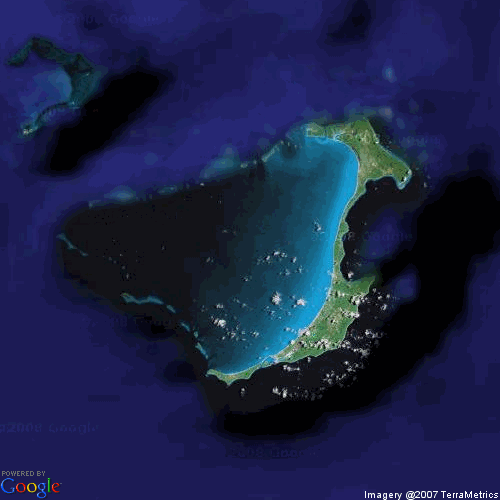
Ambrym festival videos are now available
September 10, 2008
We are in Port Vila and have just posted a few videos of the festival in North Ambrym. Just go to our photos
and video page at
https://sabbatical3.net/slides.htm
and scroll down to the video section. Select the videos from Ambrym. Laura’s favorite is “Men Cooking”.
We will be adding more photos to the blog in a day or two. We will leave Vanuatu for Ouvea in the Loyalty Island (New Caledonia) on Saturday (September 13). More on that later. M.
Mark M. Pitt
Professor of Economics
